











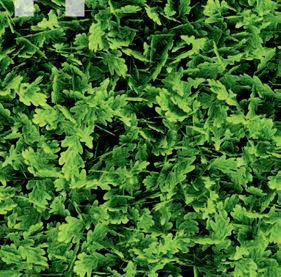
























Join our active community of about 1000 technology businesses from as little as £165pa.
With 50 events a year, CW Membership offers plenty of opportunity for upskilling your teams, networking with peers, meeting new customers, uncovering your next hire and transforming your product roadmap!
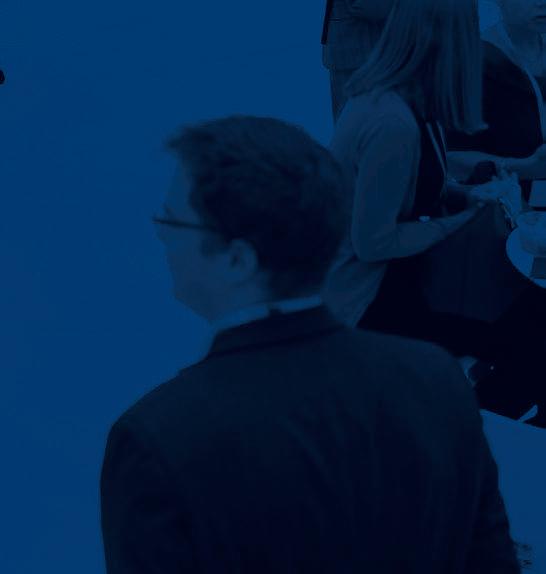
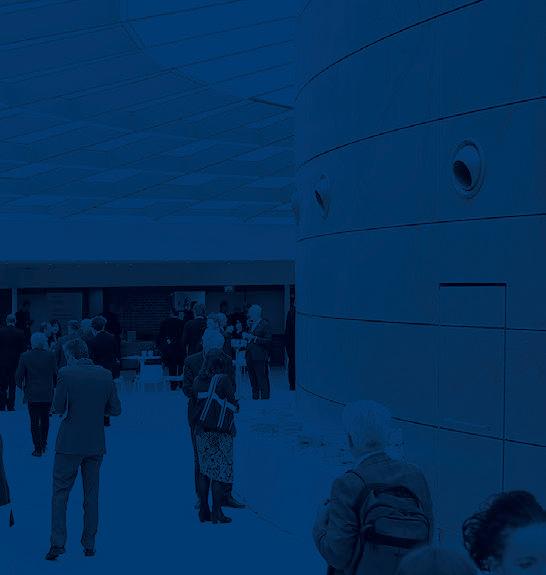



Free and unlimited access to CW SIG events for all staff
Major discounts to conferences / trainings
Custom business development support from CW Membership team
Talent recruitment through CW Jobsboard

News and event promotion through CW website
Opportunities to help lead, or start, a SIG (Founder Members only)
Free access to CW Founders’ Dinners (Founder Members only)
cambridgewireless.co.uk/about/become-member/
CLIMATE CHANGE IS the top concern for governments around the world. The UK is affirming its commitment to the Paris Agreement and the UN Framework Convention on Climate Change at the 26th UN Climate Change Conference of the Parties (COP26) in Glasgow. The new climate change commitments will set the UK on course to cut carbon emissions by 78 per cent by 2035.
The development of 5G also offers us a new opportunity to expedite this reduction through developing new resolutions.
We’ve seen first hand some of our projects within the 5G Testbeds and Trials Programme develop innovative solutions reduce emissions
During my visit to 5G Rural Dorset earlier this year we visited Lulworth Cove, where 5G connected buoys are being used to measure wave heights and sea pollution.
In North Yorkshire the Mobile Access North Yorkshire (MANY) project has developed a trial which collects data on river levels and pollution, reducing carbon and early flood warnings for residents and businesses.

5G Smart junctions aims to reduce congestion and pollution in central Manchester by using 5G technology to connect sensors at junctions, and artificial intelligence systems, cutting waiting times at traffic signals.
Earlier this year WM5G announced that ten start-ups would be working with 5PRING to pioneer green innovations using 5G. These projects have ranged from transforming home deliveries, reducing pollution through to better traffic management, and high-tech recycling
These green innovations could help the West Midlands reach their target of net zero by 2041, and showcase what can be possible across the UK using 5G.
Some of the 5G Create projects have awareness of environmental concerns at their heart. The Eden Project and Green Planet are both using virtual and augmented reality to drive home the message of conservation of resources.
UK5G has also launched a new working group this year which is focusing on climate and the environment. The group has had it’s initial kick-off meeting and is rapidly developing a plan which will help all the Testbeds and Trials projects to assess the



enviromental impact of the work they are doing. You can read about the group on page 12 of this issue.
The development of new technologies not only offers opportunities to advance productivity, enhance security of networks, provide reliability and many more, it can actually provide an additional tool in the arsenal to tackle climate change. Although innovative applications can help to reduce carbon emissions, we also need to look into the infrastructure to see how we can produce net neutral networks. As we look towards COP 26 our projects are a prime example of how businesses and communities are already taking matters into their own hands to develop solutions to reach our target of net zero emissions.
communities are already taking matters into their
 Ian Smith 5G Testbeds and Trials Programme Director, DCMS
Ian Smith 5G Testbeds and Trials Programme Director, DCMS

Head of UK5G Robert Driver
Head of Marketing Vicki DeBlasi
Content Creation and Curation



Crispin Moller


Lauren Kelly UK5G Social Media
Kate Cartwright Administration
Kerry Preston-Ladd
Contact : www.uk5g.org/about/contact/ c/o CW, Bradfield Centre, 184 Cambridge Science Park, Cambridge CB4 0GA
T: +44 (0)1223 967101 W: uk5g.org
Maeve Hickey, Mija Valdez
Chairman Keith Young MBE
Editor Simon Rockman simon@cwjp.co.uk
Consulting Editor



Andrew Orlowski andrew@cwjp.co.uk
Creative Director
Matthew Inman
Business Development Director

Roger Hinkson roger@cwjp.co.uk
Finance Director Delia Robinson
Staff Writer Jonathan Rockman



Photography Stuart Berman S tuart@bygones.org

Special Projects Alex Young
CWJP
14 Great College Street, London SW1P 3RX
T: +44 (0)20 8002 0000
NEWS
We welcome new ministers who take up the reins at DCMS and Starlink has a new earth station on the Isle of Man. There is a new tech incubator opening its doors in Worcestireshire, a round and 5G RuralDorset raises £4G for cancer research.

Many important people have signed up for UK5G’s new Climate and Enviroment working group.
28

Two projects are using robots to fight weeds. MONeH is using martain lasers while 5G Dorset has farming robots with tasers


50

Open networks need someone to make all the individual components work together.
CBP006075

38
Reusing equipment and ethical network disposal are an important way to reduce emisisons and waste. It’s not just the green thing to do with equipment shortages event the most up to date networks are finding value in buying secondhand. We visit the warehouses where mobile networks go to be reincarnated, resold and recycled.
50
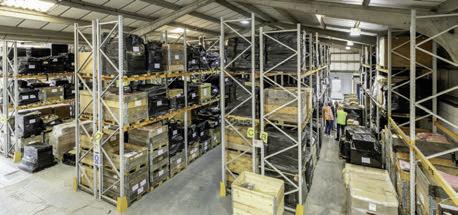
Meet Simon Blagden, the new head of the Supply Chain Diversification Advisory Council, formed to look at redressing security issues posed by limited vendor choices. The first DCMS funded competition, FRANC is underway we look at the history and future of supply chain diversity.
UK5G INNOVATION BRIEFING IS PUBLISHED BY CW JP ON BEHALF OF UK5G, THE NATIONAL INNOVATION NETWORK FOR 5G . ALL RIGHTS RESERVED. ARTICLES MAY NOT BE REPRODUCED WITHOUT WRITTEN PERMISSION FROM CWJP. OPINIONS, COMMENTSAND VIEWS INCLUDED IN THE JOURNAL ARE NOT NECESSARILY THOSE OF UK5G


COVER STORY

Fiona Harvey, award-winning environmental journalist, and writer for The Guardian looks at the need for change.
Jo O’Riordan, Head of Spectrum Policy Forum and Telecoms at techUK, looks at research the forum has commissioned on how radio regulation may affect climate change, providing better communication for everything from utilities to transport.

GEORGE FORMBY SANG ABOUT leaning on a lamppost in the 1937 film
Feather Your Nest. The song, written by Noel Gay, was a huge hit. Nearly a century later, street lights are suddenly the hot new topic. It’s no longer just a famous ukulele player, singer and comedian who sees a value in using a lampost for support.
DCMS has launched the Digital Connectivity Infrastructure Accelerator or DCIA project to map places, known as “assets” where mobile networks might attach their cells.
There is a renewed interest in making good use of the street furniture which already has the power connection. For a mobile phone cell site, you like to have some height but you need power and connectivity.
That’s what the Liverpool 5G project has been using as part of the Department’s Testbeds and Trials programme since the early days of the programme. Street lights in Merseyside not only provide power but, connectivity too. Because Merseyside lampposts have CCTV, they already have a fibre connection.
With the move to adding charging points for electric vehicles we can add transportation to communication, illumination and observation.
What that means is that there are now many more people taking an interest in the humble lamp post, not just the local authority. The Digital Connectivity Infrastructure Accelerator’s brief is to record the location of each one - something a lot of organisations will need to know.
At the moment, most local authorities have a good enough idea of where each one is to run them and maintain them – for example, where to send the cherry picker to change a bulb. But as more uses come to play there are more parameters. Organisations planning CCTV installations will want to know the line of sight – which may be different when trees are in leaf. This will also be of concern for the radio network planners who will also want an idea of the effect of signals bouncing off nearby buildings. As we move towards the endof the petrol engine the car charging networks will worry about distance from the kerb and ease of parking.
As the telecoms industry we should be aware of that there are many interested parties; these are organisations that we need to work with. Today it’s not just scent-laying spaniels which are quite so interested in the location of a lamppost.
UK5G is spreading the word to manufacturing and the creative industries.
And we look at what steps the UK mobile operators have taken, and are planning to lower the impact of their businesses to meet the need to care for the climate and environment, and their plans to reach net zero. WHILE
Travel through 5G releases requires a roadmap to the tech. Robert Driver navigates upcoming UK5G activity aimed at vertical markets

eaning case

will at least be able to stream
We live in a very different world to that of Noel Gay and George Formby, the original song was a huge hit in sheet music, but it is good to know that if you are ever “Leaning on a lamppost at the corner of the street, In case a certain little lady comes by.” You will at least be able to stream George’s films while you are waiting.
Simon Rockman Editor, UK5G Innovation Briefing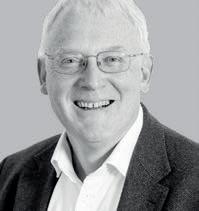
EVERY CARE IS TAKEN IN COMPILING THE CONTENT, NEITHER UK5G N OR THE PUBLISHER ASSUMES RESPONSIBILITY FOR EFFECTS ARISING FROM THIS PUBLICATION.AVAILABLE ONLINE AT CWJPRESS.COM/UK5G

NOKIA, THE FIRST major vendor to join the Open RAN industry body the O-RAN Alliance has suspended its technical work with the group. The Alliance creates specifications for open interfaces for equipment that implements 4G and 5G mobile network standards. Nokia is concerned that three Chinese manufacturers that contribute to the work Kindroid, Phytium and Inspur have been placed on the US Commerce Department’s Entity List because of security risks. Nokia has expressed concern that 44 contributors to the Alliance are Chinese government owned or controlled. All receive code developed collectively by the Alliance.
BETADEN, THE TECH accelerator based in Worcestershire has taken in its first cohort of companies to be schooled through the use of the Malvern Hills Science Park 5G testbed. This reflects the shift the organisation has seen towards applications from businesses developing technology and services powering connected technologies over recent years.
One of the cohort companies, Jet Engineering is part of the Testbeds and Trials 5G Connected Cowes project and is working with BetaDen on its 5G buoys for connected maritime applications
“Over 75 per cent of our current cohort are developing technologies that either directly use or enable other technologies to benefit from Internet of Things applications,” explains Linda Smith, founder and CEO of BetaDen”.
Areas the accelerator is particularly looking to help with include digitally-connected autonomous vehicles and app-connected EV smart chargers, data security software, services using digital twins and real-time location data to
improve production line efficiency, and Industrial IoT condition monitoring. It is the role of the programme to work through testing and refining service design as a key part of proving the technologies and ensuring they deliver real tech solutions for real world problems.
As a commercial technology accelerator, the focus lies in supporting cohort members to scale their businesses by testing and refining their offer to meet real-world demand. In some cases that also means demonstrating the benefits connected technologies could make to their business to potential customers.
Alongside business mentoring and access to industry partners, one of the biggest benefits accelerators such as BetaDen offer is access to a network of non-competing peers who support each other to work through challenges and identify new commercial applications for their ideas.
Applications to join the next cohort of technology businesses at BetaDen open in October. For further information, visit www. beta-den.com
Interest in Open RAN has grown as a way both to diversify the market from the three giant vertically-integrated telecoms suppliers that dominate the equipment market: Nokia, Ericsson and Huawei. Open RAN equipment will run on general-purpose vendor-neutral hardware.
The Alliance was created in 2018. A Nokia spokesperson described the move as a “pause” and stressed that “Nokia’s commitment to ORAN and the O-RAN Alliance, of which we were the first major vendor to join, remains strong,” in a statement.
The alliance stated that, “While it is up to each O-RAN participant to make their own evaluation of these changes, O-RAN is optimistic that the changes will address the concerns and facilitate O-RAN’s mission.”
Orange, Deutsche Telekom, Telefónica and Vodafone signed an agreement vowing to deploy Open RAN equipment on their networks. Vodafone plans to deploy the new standard in 2,5000 sites in the UK, with Samsung and NEC supplying the radio portion.
ELON MUSK’S STARLINK constellation has lit a third UK ground station in the space race to bring next generation satellite broadband to Britain.
The low earth orbit (LEO) satellites are visible as a train of bright moving lights, and operate much at a much lower altitude than older, geostationary satellites, making them more viable for both internet broadband. This will be a boon for rural areas, both as a retail offering and for backhaul between mobile base stations.
A new ground station on the Isle of Man, which links satellites in orbit to internet data
CIRCULAR 4G HANDSET





“The Cyrcle Phone” is designed to stand out from the crowd with its round screen but also combines two important new aspects which have become relevant to every day life. Elements of the design are open source and the project is designed to create the least possible waste. The case is biodegradable and the design for it freely available so that you can 3D print your own case.
The Cyrcle Phone features two headphone jacks, two SIM card slots. A temperature sensor and comes unlocked. It’s $699 (£520) through the Kickstarter campaign and will be priced at $999 (£740) when it ships in September 2022
See https www.cyrclephone.com for more information


centers on Earth, was confirmed by the Starlink.sx website and local sources. Starlink has stations in Buckinghamshire and Cornwall but this brings the network closer to the rural North, Wales and Scotland.
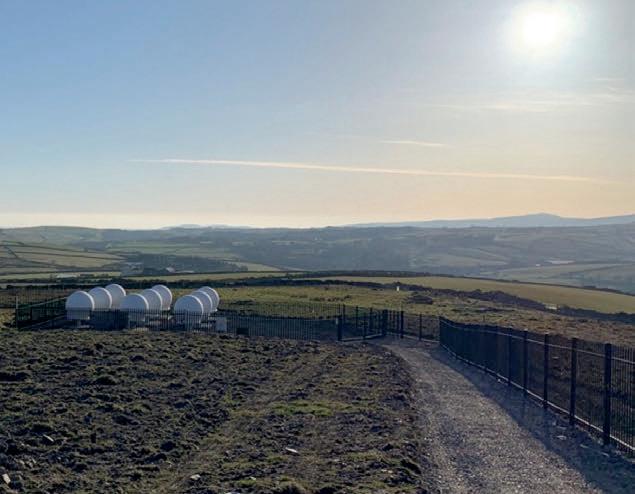
51 further Starlink satellites were launched last month, bringing the total to almost 1,500. Ultimately 12,000 will be operational according to Starlink, to the dismay of astronomers. Blue Origin, the company founded by Musk’s rival Jeff Bezos, founder of Amazon.com, plans over 3,000. OneWeb, in which the UK has. stake, has 600 planned.
http://cwjp.co.uk/satellite













The Right Honourable NADINE DORRIES has been appointed Secretary of State for Digital, Culture, Media and Sport. The new Digital Secretary brings a national media profile to job as a best-selling author. She was formerly Minister of State for Mental Health, Suicide Prevention and Patient Safety., and has served on the Commons Science and Technology Committee. Nadine has the Member for Mid Bedfordshire since 2005.


JULIA LOPEZ , 37, has been appointed Minister for Media, Data, and Digital Infrastructure, replacing Matt Warman. Prior to the role she was Parliamentary Secretary at the Cabinet Office. Lopez studied Social and Political Sciences at Queens College, Cambridge. She worked as a researcher for MP Mark Field and co-authored two books with him, and has worked as a ghostwriter. The Member of Parliament for Hornchurch and Upminster, Lopez was elected to Parliament at the 2017 general election.

THE WIRELESS industry is being asked to help shape the future.
Businesses who work with and use radio technologies are being asked to provide DCMS with their views in a consultation which closes on November 25th.
The plan to develop a national infrastructure strategy was announced by DCMS in the summer. Julia Lopez, Minister for Media, Data, and Digital Infrastructure told a techUK event

that the strategy will “set out the government’s long-term ambition for the development, deployment and the adoption of 5G in future wireless networks in the UK. To ensure we can deliver world-class wireless connectivity to the UK, driving growth and innovation in every part of our country.”
The aim of the strategy is to better understand from industry, consumers and businesses, what wireless connectivity the UK is going to ensure the UK is positioned to maximise the
potential of advanced wireless networks by 2030, and understanding of the UK’s future wireless connectivity needs, to what extent these needs will be met over the next decade and how the government can best support investment, competition, innovation and adoption of wireless infrastructure, including 6G and future networks, through the regulatory and policy framework. This research works in concert with work Ofcom has done as a review of the market.
Lopez told the audience “We want to hear from as many people in organizations as possible. And then use those responses to help us shape the wireless infrastructure strategy. I’d be really grateful if all of you could put forward a response to that.”
The strategy will set out a clear roadmap for how wireless infrastructure can play a vital role in the UK’s economy by 2030, ensuring that the future connectivity needs of the UK have been accounted for and a clear assessment of how they will be met. Government will also determine what role it should play in supporting investment in wireless infrastructure and subsequently introduce a new policy framework on how it will be achieved.
To respond to the call for evidence see https://www.gov. uk/government/consultations/ wireless-infrastructurestrategy-call-for-evidence or email wirelessinfrastructure strategy@dcms.gov.uk.
roadmaps and investment plans. The aim is to create a diverse commercial ecosystem for private 5G networks that enables large and small vendors to play a role.
The SMEs will work with Plexal, the government and industry to develop opportunities and overcome barriers that exist for startups and SMEs to play an active role in the telecoms market. These barriers could include making sure the products are interoperable and have robust cybersecurity built in.
Plexal is working with DCMS to support diversification of the UK’s telecoms market and stimulate creation of products and services from SMEs and startups.
Based at East Here the technology hub at the Olympic site in London’s East End, the Pexal team builds connections between industry, academia, investors, startups and scaleups. It has worked with leaders from the telecoms market to assess where there could be opportunities for SMEs to provide products or services. It then identified SMEs that will take part in a 12-week sprint to develop robust business cases, technology
Plexal is looking at current and future 5G private networks the two categories of fully private, where the value outcome remains isolated from the public and private today, but will need to integrate to the public network to realise all the benefits
The sprint will support the UK government’s aim of developing a domestic capability for 5G and ensuring the telecoms market includes a diverse range of vendors – including a larger number of small and medium-sized companies.
Commenting on the innovation challenge, Andrew Roughan, Plexal ‘s managing director, said “We think there’s a big opportunity to understand and develop the role of SMEs in the telecoms market.”
To find out more about Plexal and to sign up for its programmes see www.plexal.com
The closing date for applications to take part in the £4m Digital Connectivity Infrastructure Accelerator is 18th November. The programme launched by DCMS will tackle one of the key challenges to using publicly owned sites: many councils don’t know what they own or where precisely it’s located. DCIA will work with local authorities, regional bodies, expert groups and network infrastructure providers to co-design the functionality of an asset geolocation platform. The current practice for identification of telecomenabled infrastructure locations is fragmented, largely manual and lacking in uniform digital tools. The planned work will involve software architecture and data specification, to provide a view of publicly owned assets that are available for provision of advanced network connectivity.
Organisations seeking funding through DCIA will be notified if their bids have been successful in December.
For more information see: https://www. gov.uk/guidance/digital-connectivityinfrastructure-accelerator-dcia
TELECOMS IS WEARY OF being called a ‘dumb pipe’, but using other people’s even dumber pipes may greatly speed up the roll out of critical infrastructure. It is estimated that four fifths of the cost of deploying new infrastructure is incurred by civil works. DCMS has committed £4 million to finding ways to use the nation’s water pipes to carry fibre optic cables. 5G needs fibre for backhaul, and the Government hopes any lessons can feed into Project Gibabit, and improve rural 4G coverage.
Sending a cable down a pipe may mean the road doesn’t have to be lifted. The Fibre in Water competition is being run by the Department for Digital, Culture, Media and Sport in partnership with the Department for Environment, Food and Rural Affairs, Department for Business, Energy and Industrial Strategy and the Geospatial Commission.
https://www.gov.uk/government/news/ broadband-rollout-trial-to-target-hard-toreach-homes-through-uks-water-pipes
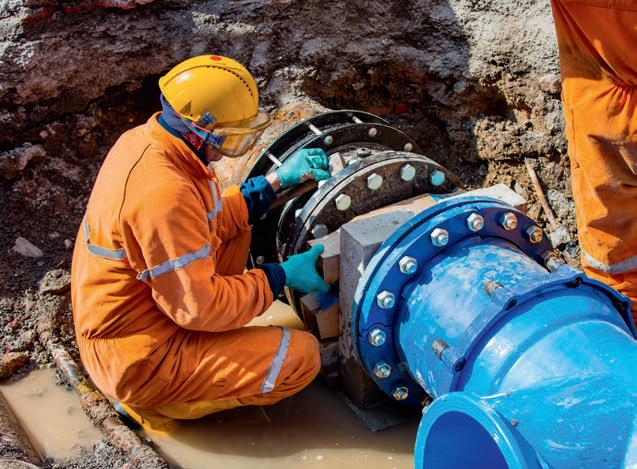
THE IMPACT OF THE GLOBAL SEMICONDUCTOR SHORTAGE ON telecoms has been examined by STL Partners. The effect of the chip shortage on the automotive sector has already been widely reported, but semiconductors have even greater impact on telecommunications infrastructure supply chains; while auto accounts for 10 per cent of global production, fully 50 per cent is acquired for ICT infrastructure – networks and datacentres – and mobile phones.
“The ongoing semiconductor supply crunch has the potential to disrupt inventories for production of smartphones, routers and IoT devices, which in turn could impact device sales and service revenues for telecoms operators,” STL reports.
The shortages are particularly acute in supply chains needing analog/radio frequency (RF) and mixed signal (SoC) semiconductors, as well as power management integrated chips (PMIC), and display driver integrated chips (DDIC)/ the latter govern the flow of power in smartphones and other wearables.
“In terms of power demands, the shift to 5G brings with it large increases in data and computing power, and with it an increase (densification) in base station antenna across multiple locations requiring connectivity, power and sensors,” analysts at STL conclude.
For example, Infineon estimates that the chip density of a 5G massive MIMO antenna is around fourfold, from $25 to $100 per radio board.
Delays of over a year on delivery of broadband routers were reported by Bloomberg earlier in 2021
Coal shortages in China hit production at Western technology giants including Apple and Tesla to a standstill, Reuters reported. Energy rationing has been introduced in many parts of northeastern China with scheduled power cuts, despite a binge in building new coal power stations. Last year, Chinese provinces granted construction approval to 47 gigawatts of coal power projects, more than three times the capacity permitted in 2019. A total of 247 gigawatts of coal power is now in planning or development, nearly six times Germany’s entire coal-fired capacity. The problem is sourcing enough coal. Last month President Xi pledged not to finance coal powered stations outside China, a pledge which has implications for supply chain diversity, as it means regional rivals such as Vietnam and Thailand lose their cost advantage.
A team from 5G Rural Dorset ran a “Tour de Testbed” sponsored cycle ride for Cancer Research, and, thanks in part to a £1,000 donation from Vodafone Foundation raised over £4,000 for the charity. The ride took the team from the most northerly trial site at Iwerne Courtney to its most southerly site in Portland Harbour, a route which included Bulbarrow, the second highest hill in Dorset. those on the ride included Colin Wood, Finn Morgan, Kieran Arnold, Pat Barretto, Paul Febvre, Jaz Hill-Valler, James Pryce, Digby Sowerby, James Thomas,Amber Brown and Dave Happy who rode on desite having been hospitalised in an accident with a car while training. You can donate to support their cause at www.justgiving.com/ fundraising/5gruraldorset
A museum which charts the history of mobile phones will launch on November 23rd. With over 2,000 handsets from 200 manufacturers it’s the most comprehensive collection assembled Curated by Ben Wood and Matt Chatterley the collection includes all the significant handsets of the past few decades. The museum is initially virtual at www.mobilephonemuseum.com but true to its name Wood and Chatterley have plans to make it a mobile, mobile phone museum and take it on the road.
One size doesn’t fit all. Mavenir has a range of private network solutions from slices on an MNO’s national network to a private RAN and cloud-based core. We meet Tushar Dhar to learn more.
It’s on, then.For years, deep trends have been taking place in technology that are only now coming to a head. Networks are turning from the corporate utility that few in an organisation know or care about, to be at the forefront of IT and digital decision making.
The catalyst for the growth of private networks has been the freeing up of spectrum for 5G around the world, says Tushar Dhar, VP of Marketing Strategy and Business Development at Mavenir.

“Fifth generation mobile networks have raised the possibility of what a modern network can do – and made fence-sitters take the decision,” he says. As the industry’s only end-to-end, cloud-native network software provider, Mavenir is one of the fastest growing companies in the sector – a global player accelerating software network transformation for 250+ Communications Service Providers in over 120 countries, which serve more than 50 per cent of the world’s subscribers.
In the UK, blocks of spectrum are being made available for private network use. 5G allows for a much richer and more sophisticated network than 4G, and a deeper integration with an organisation’s existing system. For example, 5G incorporates innovations such as the ability to “slice” networks, so a customer of a major mobile network operator can run their organisation’s data communications under the umbrella of the mobile network operator (MNO).
“Network slicing means an operator can create slices for di erent customers,” explains Dhar.

“In 4G, you can slice the core network for various customers, but it’s not the same benefit as 5G. 5G allows network slicing on the radio network basis or on the packet core basis.” Network slicing concept has been defined in the 3GPP standards for 5G networks and is capable of large scale implementations. 5G allows the network operator to customise capacity, throughput, coverage by e ciently and dynamically reallocation of resources between di erent network slices. Each slice can be tailored to a specific use case or
business application, for example, Internet of Things (IoT), the Vehicle-to-Everything (V2X) standard, factory automation and robotics.
5G also increases speeds and capacity, improves reliability and improves the latency to permit critical applications to be run – something that wireless networks could not previously guarantee. In addition, it o ers massive IoT capabilities to handle billions of connected devices, and permits exact positioning down to less than a metre. Other innovative capabilities include UPF (User Plane Function) separation in the packet core to allow distribution of the data plane and maintain centralised control. This allows for local break-out thereby handling high bandwidth and low latency application requirements at the edge. What this means is that data and or tra c moves closer to the user at the edge of the network, to increase performance of the most demanding applications.
The digital transformation of enterprises and industries has been underway for some time, and this is now integral part of any business environment. CIOs are recognising that there is an increased need for network platforms to provide context and connectivity for both people and assets. An example of how Mavenir helps make this happen is in Japan, where it’s working with NEC to deliver a 5G open virtualised RAN (vRAN) solution to the Japanese Enterprise Market. This will open up local and private 5G network opportunities for enterprises, regional authorities and other organisations.
Another example is the Moray East o -shore wind farm where telecoms provider Vilicom is providing a private mobile network for operator Vestas. It’s enhanced 4G for now, capable of being upgraded to 5G. This is an unusual case, in that besides providing advanced communications and connectivity for core business operations, it provides workers with a leisure network so they can stay in touch with family via video calls, or stream content whilst at sea. This is an example of a non-traditional network, where Mavenir’s software-defined vRAN has been turned into a practical solution for a vertical sector, in this case maritime.
Mavenir has been working with the leading IoT operator Netmore across a number of opportunities and use cases in the UK and Nordics for providing advanced communications and mobile connectivity; the use cases range from providing AR/VR experience to visitors, live streaming of wedding events, autonomous vehicle use, in-building mobile broadband coverage and multi-tenant neutral host operation.
Last year, Mavenir established a collaboration and joint go-to-market strategy with systems integrator Mugler to provide end-to-end 5G solutions including 5G vRAN, 5G Core & Digital Enablement Platform to the German Enterprise & Industry Market. Mugler will deploy this system on its campus in Oberlungwitz, Germany, to showcase advanced enterprise use cases. Similar strategic cooperation has been set-up with NTT Data and Media Broadcast GmbH to provide solutions and services for private 5G and 4G networks in Germany. NTT Data will also o er its 5G campus network as a showroom solution.
Mavenir has rich set of collaboration and partnership with key technology players. These include:
• Qualcomm Technologies for developing indoor and outdoor Open RAN solutions for both private and public network deployments
• Intel for flexRAN based COTS (commercial o the shelf) system and Smart Edge products
• NVIDIA for launch of AI on 5G hyper converged edge solution for verticals like manufacturing, mining and healthcare that cover Industry 4.0 applications, including Industrial Internet of Things (IoT), Intelligent Video Analytics (IVA) and Extended Reality (XR) and Gaming use cases
Mavenir is also partnering with companies from various industries, public and government authorities, and network operators to support the introduction and integration of private networks including applications and services. The company is also working with CSPs to help their B2B business, such as Vodafone, to provide indoor 4G connectivity for their customers.
Diversity is the key to understanding this new world. Mavenir sells the expertise to build a private network to enterprises directly, as well as through channel partners. Because networks are richer, using cloud native software with an extremely flexible architecture, Mavenir can run solutions on a public cloud, private cloud, on customer’s premises – or all three.
Mavenir offers its full portfolio of Multi-G solutions for the Private Networks market to address the needs of Enterprises, Industries and CSPs. This end-to-end 5G system (part of Mavenir’s MavEdge family), based on cloud-first, open architecture principles, is highly suited to address both mass scale private enterprise use cases as well as bespoke high-end use cases for advanced industries. This includes Radio Access, Cloud Core and Digital Enablement Platform.
“Enterprises want more control and are coming forward and deploying their own networks”, sums up Dhar.
As an example of the new hybrid world, Dhar points to Mavenir’s collaboration with Telefonica and Amazon Web Services (AWS) for providing IoT connectivity services as a private network offering for Telefonica’s business customers using both
• Mavenir’s MavAir family includes Open RAN products; the disaggregated RAN approach extends virtualisation to the edge of the network and provides strategic differentiation by enabling multisource Remote Radio Units (RRUs) to interwork with the virtualised, containerised, Cloud based software over ethernet Fronthaul (FH), using the O-RAN open interface overcoming the traditional constraints of the proprietary walled garden specifications used by the other traditional vendors.
• Mavenir’s MavCore family includes 5G Converged Packet Core solution, based on cloud-native principles, can be retrofitted on EPCs and encompasses all the major 5G core elements, and these functions are implemented as micro-
Mavenir’s packet core solution and AWS’s public cloud infrastructure.
As well as giving customers greater control, private networks are being installed for new classes of applications. Many of these fall under the buzzword ‘smart city’, which really refers to harnessing data for metropolitan areas for applications ranging from environmental monitoring to traffic management. Previously the data was either not collected at all, or siloed with a contractor or department. But a smart city private network can start to knit these disconnected parts together.
“The Smart City initiative is an important step towards exploring and find new ways in which technology and data can improve the quality of life of town or city for the people who live and work there,” Dhar thinks. “Every city wants to become connected and efficient, across the city’s administration, its education, healthcare, public safety, real estate, transportation, digital innovation and utilities.”
5G networks provide the connectivity required for vast amounts of data to be transferred and analysed. Once transferred in real-time over 5G networks, data can help reduce waste and lower cost, waste, fight crime, and help lower carbon emissions.

Mavenir is working on several initiatives in the UK taking that first step towards becoming smarter.
services in containers. The Mavenir 5G Core also combines 4G Enhanced Packet Core (EPC) functionality and offers a ‘Converged Mobile Core’ solution that supports both 4G and 5G subscribers. In addition, the Mavenir 5G Core supports all Standalone (SA) and Non-Standalone (NSA) options.
• Mavenir’s MavApps family that includes Digital Enablement platform allows Private Network operators to create a seamless way of abstracting out the complexity of the underlying network, and create a digital app store for enterprise and industry applications – thereby empowering an ecosystem of developers, service providers, technology companies, enterprises and industries to create applications to power digitalisation with 5G.
“Once cities start to think in a joined-up way, they can do much more with their infrastructure. A smart pole delivers not just street lighting but can have a sensor measuring levels of air pollution, and another doing traffic analysis (ANPR),” Dhar explains. Cities can start exploring the possibilities with 4G networks, but it’s really with 5G that they start to see benefits.
Mavenir will deliver a robust, secure and reliable 5G private network not just to UK cities, but for industry 4.0 applications, modern medicine/e-health, logistics, warehousing and agriculture. The company’s unique software pedigree means customers can manage them with ease from dashboards and portals.
Mavenir’s Private Network solutions unleash the power of the network to deliver secure, reliable and scalable solutions and unlock the innovative potential of 5G. Mavenir’s end-to-end, cloud-native, open architecture approach to private networks connects people and things through scalable, zero-touch and multi-generational platforms, with on-premise, cloud deployed and cloud hosted options. Trust the future.
For more information email tushar.dhar@mavenir.com, or visit www.mavenir.com
WHEN THE UK5G Climate and Environment Working Group appeared at the Better Connected event in April, it rapidly became a highlight of the virtual gathering. A passion for managing the impact of 5G on climate and environment was clear from the start, and the chair professor Adam Beaumont pulled together a star team of contributors and companies.
A passionate environmentalist, Adam is a Trustee of the Eden Project and non-executive board director of Eden Project International Ltd (EPIL), plus the Chair of the Eden North (Morecambe) Project. Heading up the Climate and Environment Working Group further cements his dedication to making sure future technology has a positive impact on society and the planet.
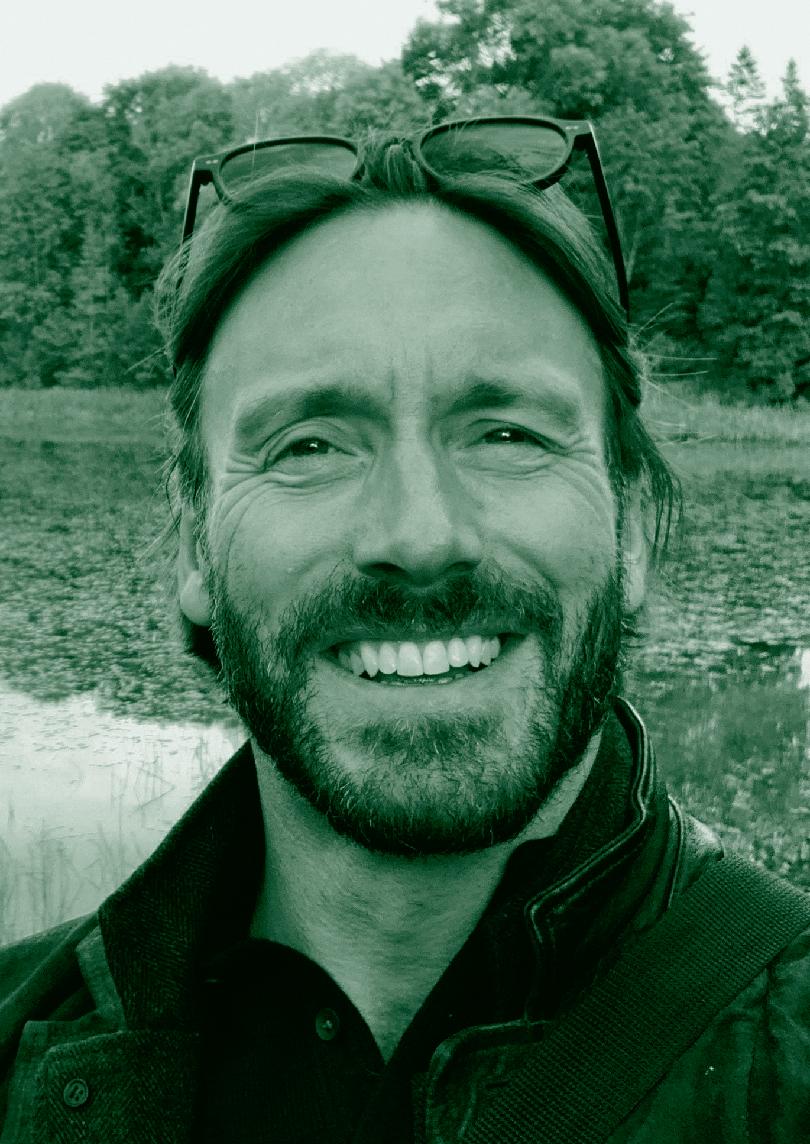
“We can’t hide away from the fact the communications industry is a significant consumer of power and resources. It’s important with such great progress being made in 5G innovation, as an industry, we focus not only on how we can strive to be ‘less bad’ to help reduce our impact, but seek to be ‘more good’, creating a positive impact for people and our planet,” says Beaumont.
“Our team are using our network to start a dialogue with external experts and projects. We’re exploring the ways in which we can reduce the direct impact of implementing future technologies such as 5G,” Beaumont continues. “But also as a team we’ll drive further R&D to make sure this advanced technology is deployed in a positive way. 5G is an opportunity to deliver a more environmentally clean communications infrastructure and this is what we’ll be
exploring as a working group.”
Beaumont says the Working Group will use the groups findings to inform twice-yearly engagement with senior Ministers and civil servants. The group wants to promote a greater understanding of the direct and indirect lifecycle impacts of implementing 5G in the UK5G community. It will work with as many of the consortia in the testbeds and trials programme as possibly can.
Part of the role also involves identifying unintended environmental consequences of the 5G roadmap, and drawing some conclusions on the real world consequences the environmental impact of the 5G roll out.
Sarah Peake is the Content Curation
Manager at The Eden Project, one of the 5G Testbeds and Trial programmes. Along with her colleague Oli Broadhead, Peake has been working with the Climate and Environment Working Group to put together a plan. “I think that first working group meeting highlighted that there’s just not enough information out there about 5G, about how it could deliver positive benefits and about the negative. And there’s more out there to support the negative impacts than there are to support the positive ones.”
Eden is now initiating a life cycle analysis on its project, and encouraging the other test beds and trials to do the same for their projects too. The Project is working with Becky Clark at Perform Green whose team is putting a skeleton together for the life cycle analysis, which will then work with the Eden sustainability manager to link the project with Eden’s own pathway to getting to carbon zero.
Peake regards it as a learning experience – sharing the lessons learned.

“And that’s how we see all of our projects. That’s why we’re called the Eden Project.” She sees the environmental benefits as a foil to the concerns over 5G and health.
“Being an environmental charity and research organization, we want to get ahead of people asking us, why are you doing this? And did you know all of these impacts? If we’re doing the life cycle assessment, we’re going to really know our impacts and how to mitigate
The newest of the eight working groups organised by UK5G is Climate and Environment, having hit the ground running it’s looking to build momentumSARAH PEAKE ADAM BEAUMONT
them in the future. And how we can turn the test beds and the trials into something that is a sustainable product.”
The Group will help inform DCMS, the Department for Business, Energy and Industrial Strategy (BEIS), and Ofcom, and act as an intermediary between UK5G and other environmental initiatives.
An experienced team boasts Mat Sears of BT, and Elisa Elschner of Vodafone. DCMS support comes in the form of Trevor Gill, who was previously Chief Scientist at Vodafone Group R&D. Ofcom is on board with Parisa Cheraghi, and joined by members from Scotland 5G, the Digital Catapult and University of Sheffield.
WITH SUCH A DIVERSE membership there are equally diverse reasons for getting involved. Professor Timothy O’Farrell, Chair in Wireless Communication of the Department of Electronic & Electrical Engineering at The University of Sheffield, has been researching energy efficiency in wireless networks since 2009, and was the Academic Coordinator of the first large scale international research programme to address energy efficiency in cellular mobile networks, the mVCE Core 5 Research Programme: Green Radio.
A mobile base station, which houses the radio network equipment, is the most energy-
intensive component of a mobile network.
Concerns about the power consumption of the networks is nothing new, Professor O’Farrell points out: “A particularly strong aspect of my research activity has been on developing metric frameworks for accurately determining energy efficiency and energy consumption in radio access networks.” This means the energy efficiency and energy consumption of the network can be quantified.
O’Farrell’s work in the Green Radio research programme has largely found its way into the ETSI industry standard ES203228v1.1.1
(Environmental Engineering [EE]: Assessment of mobile network energy efficiency’).
CHAIR:
ADAM BEAUMONT
OLI BROADHEAD
MICHAEL BURNS
PARISA CHERAGHI
BECKI CLARK
PETER CURNOW-FORD
ELISA ELSCHNER
SIMON FLETCHER
TREVOR GILL
ANDREW MELCHIOR
TIMOTHY O’FARRELL
SARAH PEAKE
DAVID PUGH
MAT SEARS
NIC STIRK
JAMES THOMAS
In turn, this prompted the mobile industry to introduce new practices, and the work influenced the 5G specifications. For example, network equipment is now energy rated. Mobile operators include energy ratings in equipment procurement specifications, too, and the 5G standards introduce new network functionality such as sleep-modes to reduce energy consumption. All these practices have helped reduce CO2 emissions, but the Professor isn’t resting on his laurels.
“Metrics frameworks need enhancing, and models to predict energy consumption and methods to measure energy consumption also need to be enhanced and made contemporary,” he says.
“These techniques and models need to be applied to realistic 5G deployments to both determine their energy efficiency and energy consumption and more importantly to develop models that can predict energy efficiency and consumption.”
The intention is for the frameworks and measurements to contribute to the architecture design practices in mobile networks for reduced energy consumption.
“This is a continuing challenge, as there is no underpinning theory of how to design energy efficiency networks with low energy consumption,” Professor O’ Farrell notes. “In

addition to evaluating the 5G technology used to create a network, the Group should also address how 5G as an ICT resource can be used innovatively to reduce energy consumption in other societal applications where CO2 emissions are high.”
One challenge for 5G is that more bandwidth and higher frequencies entail a higher density of network infrastructure. This increases energy usage significantly, but O’Farrell believes that the problem can be minimised.
“An analogy is lighting in a building. You can keep adding lights while consuming the same operational energy, provided the unused lights are switched off. For wireless networking, turning infrastructure on and off, potentially rapidly, is very difficult. Given that further systems intend migrating to very high frequencies (subTHz), then further densification is almost a certainty,” he notes. “Therefore, alongside further densification we need to innovate at the network level and express this innovation in the standards.”
James Thomas is the CEO of JET Engineering System Solutions, building a maritime connectivity business looking to help a number of environmental use cases.
“When we realise that 71 per cent of the planet is the Ocean we realise how important it’s role is in climate change,” he says. Thomas is working on creating a floating 5G at Sea network.
With a history of having worked on hydrogen generation and electric vehicles, Thomas says “We need to take a full lifecycle analysis and look at how not only how the network uses energy but how products can be designed to be repaired and reused.”
The UK5G Climate and Environment Working Group has got off to a strong start. The benefits will be felt well beyond the 5G testbeds and Trials programme. The members held their first meeting in the depths of lockdown virtually - but perhaps for a team which is dedicated to reducing the impact of fossil fuels that was appropriate
New, British technology has the ability to reduce the power consumption of mobile networks equipment and operating costs. Eric Dowek, Marketing Director at AccelerComm explains.

In many aspects of engineering there is a virtuous circle. If you make a car lighter it needs smaller brakes, a smaller engine and you improve performance and fuel economy. That in turn means it can be made lighter. The same is true of mobile phone networks. If you can improve the efficiency of the radio, both in the handsets and the base stations, you can have faster data transfer, fewer cell sites and better battery life.
Technology developed by Professor Rob Maunder at the University of Southampton in 2016, has been spun out into AccelerComm which has established itself as a global leader in 5G New Radio physical layer IP, which increases spectral efficiency and reduces latency of the 5G Radio Access Network. The physical layer is where hardware meets software. Improving the efficiency of this has a knock-on effect to the whole of the radio network.
High spectral efficiency is crucial
in protecting cellular and other radio networks from insufficient capacity, low data rates, sparse coverage, and poor quality-of-service. Despite the roll-out of early 5G networks these factors remain an issue that impact customer experience and risks stifling new service revenue opportunities for operators. Improvements to spectral efficiency can also be used to significantly reduce infrastructure equipment and operational power consumption, with less equipment needed to provide the same network performance.
The company’s IP is playing a significant role in helping to optimise the performance of Open RAN. While open systems offer significant benefits is to create a rich and broad ecosystem of vendors, with specialists in various components collaborating to drive technical breakthroughs and developments the extra standards and interfaces can impact performance.
Research from the industry analyst firm Mobile Experts quantified the impact of the efficiency improvements of AccelerCom technology on a typical Open RAN US mobile operator as saving around 20% of base station equipment costs and operating power consumption
Nowhere is this challenge more apparent than in the radio network itself. The spectral efficiency of a radio network (bits/sec/Hz) is a key indicator that defines how efficiently an operator is using the spectrum that in which they have invested. By relying on generic products, often derived from Wi-Fi or broadcast, Open RAN operators face significant impacts in the performance of their network in terms of spectral efficiency and performance, with more equipment required to serve the same number of customers.
AccelerComm’s complete Open RAN 5G channel coder/decoder design can bring dramatic benefits: Recent research from the industry analyst firm Mobile Experts quantified the impact on a typical Open RAN US mobile operator as saving approximately 20% of base station equipment costs and operating power consumption. The AccelerComm IP packages can be quickly integrated and flexibly delivered for use in custom silicon (ASIC), programmable hardware (FPGA), or as software solutions. The company is already working with Intel, Xilinx, Silicomm, and many others. Driven by a leadership team comprising executives and senior talent from ARM, Qualcomm and Ericsson, AccelerComm was recently named in the EE Times Silicon 100: Emerging Start-ups to Watch and continues to push the state-of-the-art in 5G physical layer technology.
accelercomm.com @AccelerComm

With each new generation of mobile technology we’ve seen significant increases in the amount of land used, power consumed and waste generated by the mobile industry. With 5G we are seeing a new way of thinking about the effect on the enviroment from the industry.

EXTREME WEATHER around the world this year has set swathes of the US and southern Europe on fire, while Siberian and northern Canada sweltered in record heat, and devastating floods swept central Europe, China and other regions.
As a landmark scientific report – the sixth assessment by the Intergovernmental Panel on Climate Change, the world authority on climate science – made clear in August, the extremes of weather we are increasingly seeing around the world are the results of a rapidly changing climate. The IPCC found that human actions, in burning fossil fuels and destroying forests, was unequivocally behind shifts in the earth’s climate systems, which were likely to get much worse. The UN secretary-general, Antonio Guterres, warned the assessment signalled “code red for humanity”.
The earth has warmed about 1.2C above pre-industrial levels – that may not seem like much, but recall that the last ice age was only about 5C colder than we are today, and that the temperatures and other changes now seen are unprecedented in hundreds of millennia, and in some cases millions of years. The climate is sensitive to even small amounts of extra heating, and the carbon dioxide we are pouring into the atmosphere at still-increasing rates is raising temperatures inexorably.
Heatwaves, droughts, floods, sea level rises and fiercer storms will result from further heating, causing widespread disruption and damage to food production, water availability and infrastructure. The only way to stop further damage is to cut carbon dioxide emissions to zero by mid-century, and emissions must be halved in this decade to stay within 1.5C of warming, the threshold of safety.
Governments will meet in Glasgow this November for a vital UN climate summit, called Cop26, at which each is charged with setting out a fresh national plan to cut greenhouse gas emissions this decade. These plans, called nationally determined contributions or NDCs, form the blueprint for humanity’s actions to tackle the climate crisis.
The Mersey Forest is an ambitious project to plant 10 million trees. Measuring how effective it is involves a novel technology from Aeternum Innovations, a small Liverpool based company. The pollution microsensors harvest ambient RF (radio wave) energy and augment it with solar power, which means they can be distributed through a city without the need to attach them to the power grid. The data is sent back to the local authority using either of the 4G Internet of things standards (LTE-M or NB-IoT) or even lower power LoRa standard.

























For the UK, as host nation, the NDC set out by prime minister Boris Johnson late last year will require cuts in emissions of 68% by 2030 and 78% by 2035, relative to 1990 levels. These are steep cuts and will involve the whole of the UK’s economy. Renewable energy will be ramped up, with massive new investment in offshore wind, with the decarbonisation of electricity generation, heating and transport all key goals. But all industries must play a part, including technology and communications.


The UK has already been a world leader in reducing emissions, with greenhouse gases 45% lower in 2019 than they were in 1990. The biggest falls came from the energy sector, but industry also cut emissions by between a quarter and a third.


The UK has already been a world leader in emissions,reducing with greenhouse gases 45% lower in 2019 than they were in 1990
However, carbon reductions in some key areas have stalled. The pandemic has also complicated matters, as emissions fell drastically last year during the lockdown but have since rebounded, particularly in transport. What will the future of work look like, and can some of the changes made during the lockdowns yield positive lasting structural shifts that will decrease energy use or carbon emissions on a permanent basis? These are key questions companies must grapple with.
GLASGOW, WHERE 30,000 people are expected to attend the conference, will be the moment of truth when governments must show how they plan to stave off the worst consequences of climate breakdown. But it will also provide a unique opportunity for the UK to showcase its expertise, its entrepreneurial abilities, its innovations and new technologies. Cop26 is the time for Britain to demonstrate how going green can be economically beneficial as well as saving the planet. UK companies with a green story to tell will find a receptive global audience – conversely, businesses attempting
greenwash will find themselves under the spotlight of activists and in the glare of the world’s media.


The government, with the UN, is backing a Race to Zero campaign for businesses, spearheaded by green business advocate Nigel Topping, the highlevel climate action champion for Cop26. Companies signing up to the Race to Zero must demonstrate that they are preparing their businesses for the low-carbon transition. That means reducing their own emissions, by becoming more efficient in their use of energy, buying their energy from renewable sources, switching to electric vehicle fleets, and seeking lower-carbon ways of working. It also means investigating the supply chain, to ensure that suppliers and partners are also using the lowest-carbon techniques and technologies. Finally, companies must also have a plan to cut their “scope 3” emissions – the emissions that arise from the use of the products and services they sell. For many companies, particularly in the communications sphere, the scope 3 emissions will be hardest to cut, but finding ways to deal with them will be essential to any low-carbon future.
The term net zero has generated some unfavourable reaction from activists, including Swedish youth campaigner Greta Thunberg. They have questioned the “net” part of the slogan – that is, the concept that once all emissions have been reduced as far as possible, any remaining carbon released into the atmosphere as the result of our activities can be balanced out by increasing the uptake of carbon dioxide from the air. That can be achieved by creating new or improving existing carbon sinks – chiefly forests, as trees absorb carbon dioxide as they grow and can hold it locked up for centuries.

This practice is commonly known as carbon offsetting, and has been widely adopted – and just as widely condemned, because many offset schemes have been found to be unreliable, and in the worst cases even fraudulent.








Even in the case of well-run offsetting schemes, an over-reliance on offsetting to reach net zero is a cop-out, and will swiftly be recognised and condemned as such by green campaigners. We cannot offset our way to net zero – there isn’t room for all the trees that would be needed, and as trees take decades to absorb carbon they cannot be an excuse


for emitting tonnes of the gas today. The climate is changing too fast for that.
Companies seeking a credible path to net zero may still be able to offset a small sliver of their emissions, but only when they have shown that they have reduced all of their other emissions as far as possible, and have plans to phase out what remains in future.
Some net zero plans also rely on heroic assumptions about future technology, such as hydrogen or carbon capture and storage, coming to the rescue years down the line. That too is unrealistic – the International Energy Agency has made clear that the technology needed to cut the majority of emissions today is already widely available, but needs to be taken up far more enthusiastically. That means energy efficiency as a primary priority, as well as investing in renewable energy.
The good news is that the cost of renewable energy has fallen rapidly in recent years, making it now comparable with fossil fuel production, while other technologies such as electric vehicles and better batteries have also caught up. Efficiency measures yield their own payback, and there are now government incentives in the form of the super-deduction announced in the last budget that will assist companies looking to invest in new measures and equipment. It is now cheaper than ever to go green – and more urgent.
Fiona Harvey is an awardwinning journalist who has covered the environment since 2004, at the Financial Times and subsequently for the Guardian newspaper. She has written extensively on every environmental issue, from air pollution and biodiversity to ocean plastic and climate change. Her assignments have taken her as far afield as the Arctic and the Amazon, and she has attended almost every UNFCCC Cop since 2004, including reporting live from the 2015 Paris conference. The long list of major world figures she has interviewed includes Antonio Guterres, Ban Ki-moon, Tony Blair, Jose Manuel Barroso, Noam Chomsky, Mikhail Gorbachev and Sir David Attenborough. Among numerous awards and recognitions, she has twice won the Foreign Press Association award for Environment Story of the Year, the British Environment and Media Awards journalist of the year, and in 2020 she was named in the Woman’s Hour Power List of 30 top UK women, focusing on Our Planet.projects.
THE TELECOMMUNICATIONS and computing industries may contribute less than 1.5 per cent of all manmade carbon emissions, but few industries can boast such a positive impact. Research conducted by Ericsson reports that the need for physical journeys, and enabling efficiencies in sectors such as utilities, manufacturing and transport, ICT can have a tenfold effect on the reduction in emissions. But the industry is far from complacent, and is examining the environmental impact it makes. This isn’t always easy. For example, a core value of mobile network is its reliability, aspiring to ‘five, meaning its available for 99.999 per cent of the time, or all but five minutes a year. But this comes at a cost. It requires the duplication of equipment and infrastructure, which in turn consumes power. In rural areas, particularly in emerging nations, this may mean installing base stations powered by their own diesel generators. Cost savings have always driven power consumption, but in the past, the relationship between capital expenditure and operating costs was not calculated into an explicit environmental impact. Using fossil fuels provides cheap, reliable power, but renewable sources are less reliable, and so must be backed up with batteries - making them very much more expensive.
With regulation and public opinion as driving forces the motivations for the telecommunications industry are changing. And the equation is getting easier to balance. Solar cells are becoming more efficient with the introduction of compound semiconductors, which means less land has to be bought. Photovoltaic panel prices are coming down thanks to huge increases in manufacturing scale, and battery power densities are improving. Technologies such as flow batteries can work well with renewable power such as wind, solar and tidal which are not continuously available.
BT has set impressive targets. The company plans to be net zero by 2030 and require its suppliers and customers to do the same by 2040. It’s an ambitious step, upping the ante from a previous target of 2045. In the last year BT consumed 2.5 terawatts of electricity - for operations that now 100 percent renewable.
It’s a path the company has been following for 30 years, and it was one of the first to set a carbon reduction target in 1992. In 2008, set out to reduce its carbon emissions intensitythe ratio between earnings and emissions - by 80 percent. Having achieved this four years early in 2016, the company set a new target in line with the most ambitious aim of the Paris Agreement, aligned to a 1.5ºC pathway. This
target to reduce the emissions intensity by a further 87 percent with a deadline of early 2031.

But BT’s statement on climate change is more than just a list of ambitions. It’s working with suppliers to help them reduce their carbon emissions by 42 percent by 2030. BT can now boast that it has reduced the emissions intensity of its operations by 57 percent since 2016/17, and has reduced overall carbon emissions by 19 percent in its supply chain over the same timeframe.
The company can claim that consumers who buy mobile or broadband from EE, BT or Plusnet are already supplied by networks that are powered by 100 per cent “clean power”. Progress on carbon reduction and on digital skills training now makes up part of the bonus calculation for eligible BT colleagues.
Since BT is also a fixed line operator with a customer base of 30 million households, it is well placed to help consumers cut their own carbon footprint, should they wish to. A report produced for BT by Accenture claims that switching fixed access data away from Fibre to the Cabinet to Fibre to the Home, along with closing less-efficient legacy technology, could lead to a potential seven-fold improvement in energy efficiency. The Accenture analysis suggests that from 2029, decisions to retire legacy 3G mobile networks, and migrate customers onto 5G will decrease the energy demand of mobile networks, contributing to the overall decrease in energy demand of 10 per cent between 2020 and 2030.
Vodafone has announced an ambition for net zero by 2040. It will aim to eliminate all carbon emissions from its own activities as well as from the energy it purchases. The company also aims to halve its carbon emissions from joint ventures, supply chain purchases and business travel, as well as from the products it sells, by 2030, and will eliminate carbon emissions from its UK operations by 2027. As
Meeting the guidelines set out by government is a given, but most of the mobile operators have significantly more ambitious plans.One pioneer in this space is Bladon Jets, a company which builds microturbines. Once slated for the Jaguar CX-75 sports car, the small factor jet engines have been repurposed to produce 12kW of clean power, running at speeds of up to 140,000 rpm, the sealed power plant uses air bearings while the microturbine shares the same rotating shaft as the alternator. While the Bladon jet does produce carbon emissions it can be run on Hydrotreated Vegetable Oil which reduce the net CO2 emissions by around 90 percent.
All companies are encouraged to understand effects of not only their own emissions but those of suppliers and customers. Increasingly organisations are asking suppliers to give undertakings to meet targets which are inline with the purchasing company’s goals. Greenhouse gas emissions are categorised into Scopes. Scope 1 covers direct emissions from owned or controlled sources. Scope 2 covers indirect emissions from the generation of purchased electricity, steam, heating and cooling consumed by the reporting company. Scope 3 includes all other indirect emissions that occur in a company’s value chain.
enough to power a town of 65,000 people for a year, and the equivalent of 25,000 tonnes of carbon dioxide. Vodafone UK is also using the Internet of Things technology to help scientists learn how effective trees are at absorbing carbon dioxide from the atmosphere.
The network has completed trials of a new 5G radio, the Ericsson AIR 3227, that helped energy consumption decrease by a daily average of 43 per cent, and as much as 55 per cent at off-peak times, and vows to deploy 1,500 units by April 2022. Andrea Dona, Chief Network Officer, Vodafone UK, said: “Our strategy is simple; turn off anything we don’t need, modernise our network where possible, and use the most energy efficient options available without compromising the service we deliver to our customers. The success of this trial allows us to explore new ways we can more effectively manage the energy consumption of our network with our partner Ericsson. There is no silver bullet for managing network energy consumption – it is about putting sustainability at the heart of every decision and adding up all the small gains to make a material difference.”
In another example of saving costs and reducing environmental impact, Vodafone has been working with Ericsson to use drones to inspect cell sites. HD video-quality cameras and LIDAR create millions of datasets that build a ‘digital twin’ of the site, a virtual replica. Instead of sending several engineers to the site, sometimes more than once, data and imagery can be collected by one specialist drone operator.
of July 2021, the company’s European network will be 100 per cent powered by renewable electricity. All of the new targets have been approved by the Science Based Targets initiative SBTi, an initiative set up by the CDP (formerly the Carbon Disclosure Project), the UN Global Compact and the World Wide Fund for Nature. The organisation encourages the private sector to set targets in line with the Paris Agreement.

To spread the word on renewable energy, Vodafone has turned to flower power and installed a solar energy ‘Smartflower’ at its Newbury campus. A foldable, rotating array of petal-shaped photovoltaic solar panels, the Smartflower produces up to 40 per cent more power than conventional solar panels.

The Austrian-made installation is heliotropic: it rotates on its axis and tilts so that it always maintains the optimal 90-degree
angle to the sun, mimicking the behaviour of a sunflower – which also turns to face the sun throughout the day. Although just 4.8m in diameter, the Smartflower is capable of generating more than 5,000 kilowatt hours (kWh) a year – more than enough electricity to power a four-bedroom house over the same period.
It is also self-cleaning. Once the sun has set, the Smartflower folds up its petals and integrated brushes sweep away dirt and dust. This helps maximise efficiency. It also folds up automatically when it detects high winds.
Vodafone plans to install 10 of these Smartflowers at office locations in the UK, South Africa, Germany, Spain and Italy, as visible symbols of its commitment to reducing its carbon footprint.
In the UK, Vodafone claims to have cut its energy usage by 100 gigawatt hours, which is
Vodafone is also using IoT and artificial intelligence to monitor base stations, a technology it calls Smart Sites, to manage issues remotely. By reducing the number of people travelling, often to remote and difficult to reach locations, Vodafone’s impact on the environment can be reduced.
Vodafone has developed a detailed climate strategy across agriculture, manufacturing and transport. There has been good progress but the company is looing to do more. Westminster political consultancy WPI has worked with Vodafone to look at how different digital technologies might be valuable in the battle against climate change. Among its recomendations Vodafone wants to see the setting of targets for the adoption of digital technology as part of industry’s net zero strategy. It sees huge potential to harness 5G and IoT improve energy efficiency and reduce emissions.
Virgin Media O2 is the outcome of a merger between Liberty Global, owner of Virgin Media, and Telefonica, which owned O2.
Virgin Media is ambitious: Net zero carbon and zero waste operations by end of 2025. It is looking to transition its fleet to electric vehicles and targets a reduction in operational footprint by the end of 2025, on track to support parent company Liberty Global’ s target of 50 per cent reduction by 2030. To achieve this VMO2 will source 100 per cent renewable electricity and invest in carbon offsetting schemes for the remaining emissions. It will also look reduce supply chain emissions by 50 per cent by 2030
One approach Virgin Media is taking which marks it out from the other telecommunications companies is supporting the rollout of on-street electric vehicle charging through Liberty Charge. It will also use its TV platform and partnerships to “amplify and encourage engaging climate content”. Every broadband or TV product sent to customers will contain at least 75 per cent recycled plastic content, or be a refurbished product. This is expected to save over 5,000 tonnes of waste through avoiding material in design, using recycled content and refurbishing and reusing customer products. The company explains “We have millions of electrical products in customers’ homes, a logistics operation that sends equipment around the country, we dig miles of trenches to expand our network, and we have over 11,000 people working across the country. All of this means we have a responsibility to address the waste we produce, and create a more circular model where material is valued and kept in use, so
From before the merger, O2 has a detailed plan of its own for achieving net zero in its own operations by 2025. It is also looking to reduce emissions from its supply chain by 30 per cent to the same timescale. It has produced a guide for businesses on reducing their carbon impact which can be downloaded at: https://connect.o2.co. uk/ourjourneytonetzero-ty. This details how O2 is working towards its targets. In some instances, this requires a lot of co-operation. Some cell sites are hosted on building where space is leased and power is provided by the landlord. O2 is working with the property owners to incentivise them to buy power from renewable sources - a project which has been running for some time. In 2016, O2 became the first organisation in the world to receive the highest-level (Level 3) certification for its supply chain from the Carbon Trust Standard. Like its Virgin Media sibling, O2 is looking to bring its numbers down as far and fast as possible through engineering, and then get over the line to net zero with offsetting and greenhouse gas removal.
By contrast with EE, Virgin Media O2 and Vodafone, Three is only just starting down the green path. It explains on its website http://www.three.co.uk/socialcommitment/environment “We’re committed to limiting the effect we have on the environment. So, we’re working with the Carbon Trust to understand our own carbon footprint and aim towards net zero. As part of CK Hutchison Group Telecom Holdings Limited, we’re setting a net zero goal, to be validated during 2021.” There is an employee forum with green champions and by using DPD for logistics 15 per cent of deliveries were by
The Spectrum Policy Forum has commissioned a report into the role radio spectrum policy can play in helping to combat climate change. Jo O’Riordan, Head of Spectrum Policy Forum and Telecoms at techUK, explains.
OPENING THE SUMMARY OF THE Intergovernmental Panel on Climate Change’s recent report with the line “It is unequivocal that human influence has warmed the atmosphere, ocean and land ” is a clear message to leaders, policy makers, businesses and people to act on climate change now.
Many governments have set ambitious targets, including the UK administration which has committed to a 2035 deadline for cutting emissions of greenhouse gases by 78% compared to 1990 levels. This would take the UK more than three-quarters of the way to reaching its goal of net zero by 2050. Yet it is widely acknowledged that achieving these targets are highly challenging and requires action across several sectors.

One of these cross-cutting sectors is telecoms. The International Telecommunication Union states “ICTs and radiocommunications in particular are essential tools in the move to combat climate change.” Examples include terrestrial and satellite systems contribution to the monitoring of carbon emissions, as well as the role telecommunications plays in connecting people without the need for physical travel. An aspect of the technology that the COVID pandemic has vividly demonstrated. Spectrum underpins our modern lives way beyond mobile phones and WiFi. It enables us to use some car keys and doorbells, utilise machine control, traffic lights and water treatment. Spectrum is expected to play a growing role in the future development of many other sectors of industry By providing more efficient solutions to delivering and accessing products and services, mobile technologies enable a level of avoided carbon emissions many times greater than the carbon footprint of mobile networks themselves. It is very possible, therefore, that spectrum availability and management will have an impact on important areas such as climate change.
The Radio Spectrum Policy Group (RSPG), which advises the European Commission, recently closed a public consultation on this topic, the responses should be published by the end of the year.
Photograph Stuart BermanThe draft of the report covers areas such as encouraging companies in the industry to use environmentally friendly energy sources and to develop energy efficient standards and to design services and equipment based on those standards. The RSPG recognised that the availability of large contiguous frequency blocks per operator could avoid the energy consumption associated with the support of multiple carriers and carrier aggregation. It advised Member States to improve the energy efficiency of networks by making available spectrum in the largest blocks possible where appropriate.
It also notes that site sharing – both active which shares the radio network – and passive – which just shares sites, reduces the environmental impact of radio networks. In a similar efficiency vein the draft report highlights the importance of harmonisation, that is to say all European countries using given frequencies for the same purpose.
And it looks to wireless charging of electric vehicles as an area where spectrum has an important part to play. The European report noted that not only did the use of radio have an impact on the environment, there was a role in monitoring it, and that Spectrum is used in weather forecasting, monitoring climate change and gathering long-term climate related data.
In particular it highlighted the importance of effective functioning of existing 5.6 GHz meteorological climate monitoring systems. While the European Commission have the RSPG to provide advice, here in the UK the UK Spectrum Policy Forum (SPF) acts in a similar way: providing an expert sounding board to government and Ofcom on medium to long term spectrum policy.
Jo leads the work of the UK SPF at techUK. Prior to her appointment in 2018 Jo held several policy and public affairs focused positions, the most recent of which was at Smart Energy GB.
It’s important to note that, whilst in the UK Ofcom regulates spectrum, it currently does not have duties relating to the environment. In 2010, it briefly looked at the potential impact of climate change on spectrum use, but in the 2021 “Supporting the UK’s wireless future statement” it decided “not to make environmental impact of spectrum use on of the objectives in our spectrum vision, at this time.” This obviously could have a significant impact on the way that spectrum policy may impact on climate change.
Therefore, UK SPF’s Steering Board, which is made up of government, Ofcom, and industry representatives, has commissioned a study to explore what role radio spectrum policy can play in helping to combat climate change.

The study, by Plum Consulting, will cover each area of spectrum use, considering both how differences in spectrum holdings will impact how users build networks and connections (and therefore how environmental impacts will be divided between equipment rollout and ongoing power supplies); and how use of spectrum can impact on environmental welfare.
The study will also consider how environmental concerns must exist alongside economic and social welfare factors. Once the study has established the potential impacts, it will provide several recommendations of how spectrum policy should take account of climate change going forwards.
The report from Plum Consulting on the role radio spectrum policy can play in helping to combat climate change will be published shortly and will be available from techUK at www.techuk.org
techUK provides the secretariat function for UK Spectrum Policy Forum, the sounding board to UK government and Ofcom on medium to long-term spectrum issues, and supports the delivery of techUK’s Communication Infrastructure and Services Programme. It is also a cross-industry ‘agent’ for promoting the role of spectrum in society and the maximisation of its economic and social value to the UK. It does this by exchanging news and views on developments in using spectrum, drawing on industry expertise from around the world.
Telecommunications is the supplier to industries ranging from agriculture to zoology, and given how much modern communications contributes to the reduction of global carbon emissions, the mobile industry could have been excused for thinking it was exempt from keeping its own house in order. There are so many stories of how telecommunications allows other businesses to reduce their carbon footprint one could have seen a mindset that pleaded to be a special case.
But operators have a history of achievement and a strong sense of purpose, and in the main, have taken up the challenge, and examined what they can do to reduce their own environmental impact. Perhaps there is a little abdication of responsibility – buying green power isn’t quite the same as making your own with cell sites powered by wind, solar, heat pumps and tidal waves – but that will come. Using carbon offsetting is far from ideal, but the operators realise that this can only be an interim measure.
The answer to the question “How green is the 5G industry?” was, and always will be “not green enough”. The encouraging thing is that the industry recognises this, has made progress so far, and is striving to do better































SOMETHING CURIOUS IS happening in English fields. In Wiltshire, the MONeH project is driving a remote controlled buggy across the furrows. It’s touting the same laser scanner that NASA’s Perseverance Rover is using, 34 million miles away on Mars. Every so often, the robot buggy stops, and drives a probe three feet into the Wiltshire soil. Meanwhile in Dorset, robots of various shapes and sizes can be seen potographing plants. What’s happening in the fields of England could have far reaching effects for our planet.

The Dorset robots are the most visible sign of a trial called Future of Food, by 5G Rural Dorset. The buggies come from the Small Robot Company (SRC) and it received a boost by signing a research collaboration with global chipset manufacturer Qualcomm, to bring one of 5G’s most powerful features to the countryside. Along with Wessex Internet and Telint, the project will develop and prove a blueprint for rural-optimised 5G connectivity, as well as developing the world’s first 5G-ready agrirobot for arable farms. The Wiltshire buggy, in a project led by Telet Research, is focusing on improving the productivity of our fields, taking soil samples, and compiling data for a company called Map of Ag.
These two projects represent a revolution in farming similar to what big data analytics like Opta and Prozone did to elite sports, like football. Data has revolutionised both tactics and the individual technique of players, but the analytics companies needed to train their cameras on each player before they can provide the data to analyse. In the same way, Map of Ag’s MONeH buggy produces a sophisticated chemical map of the field’s soil. The feedback will allow the farmer to apply their fertiliser much more carefully and selectively, just as a football manager now knows from data analytics when to apply a close press, and where to hurt the opposition.
That matters, because not only are nitrogen fertilisers expensive, but they cause environmental degradation, too. The Haber Bosch process which facilitates the industrial production of nitrates was a by product of the imperial arms race for a source of gunpowder –but it’s credited as one of the greatest scientific breakthroughs in human history, and reducing famines in the 20th century. Nicknamed “bread from air”, as it increased the productivity of the soil many times over. Nitrogen rich fertiliser helps produce the high quality, high volume,
Neighbouring 5G Testbeds and Trials projects have taken different approaches to increasing crop yields while reducing enviromental impact.Illustration Pat Higgins phiggins80
farm produce we need. Today, Britons Britain’s farming ranks amongst some of the most efficient in the world. But there is a cost.
Excess nitrogen can end up into watercourses, which feed algal blooms. These consume oxygen as they decompose, and create dead zones in the water, killing the aquatic life. If the nitrate in the soil becomes imbalanced then vital nutrients that plants need, such as magnesium and calcium, can become depleted. The resulting soil can be infertile. Nitrate use has been declining in the UK since the 1990s, but because of the way the fertilisers filter down through the aquifer, the peak might not be reached for another 60 years. This is the ‘Nitrate Time Bomb’ the British Geological Survey warns about. Parliament was told that in 2015, 37 per cent of groundwater bodies were failing in their objectives.
Excess nitrate fertiliser also worries climate scientists. It generates N2O, nitrous oxide, better known as laughing gas. This is a trace atmospheric gas with 300 times the impact of carbon dioxide. Nitrous oxide is now thought to be one of the biggest culprits for depleting the ozone layer, and wasn’t regulated by the 1987 Montreal Protocol, which banned CFCs. It persists in the upper atmosphere for 120 years. The alkaline air created by high nitrogen levels also damages peat bogs, which are a major store of carbon dioxide. The Haber Bosch process used to manufacture nitrogen fertilisers now contributes one percent of all carbon dioxide production on the planet.
“It’s fair to say that nitrogen is arable production’s biggest liability,” says Map of Ag’s Head of Sustainability, Hugh Martineau. “As an industry we have become accustomed to applying almost ‘insurance levels’ of nitrogen; using standard applications based on bestcase scenario yield predictions to determine what a crop might actually need.”
So how does a farmer know if they’ve used too much nitrogen, or not enough? The traditional solution was to take the soil samples back to the lab, analyse it and then produce the spreader data, which was returned to the farm on a USB stick but, with the quality of rural broadband and the vast amount of data
involved, it is a cumbersome process.























Using the probe with 5G improves on this method in several ways. The feedback allows the farmer to apply the nitrates much more selectively. Problem areas can be identified, re-scanned, and those areas which missed their dosage of fertiliser can be identified and scanned while the equipment is still in the field. The processed information can then be uploaded to the spreader. The turn-around time between starting scanning and starting fertilising can be reduced from several weeks to a few days –which is enough to time to make the necessary amendments. This can allow higher yields, and a much more careful application of the fertilisers.
“We felt that there was an opportunity to really try and push the envelope with 5G, to see if we can automate and almost really do it in real time,” explains Clive Blacker, Head of Business Development at Map of Ag.





“There’s a lot of data, particularly with the laser core analysis of the soil, there’s a lot of data to pass which at best would sort of work on 4G probably, but with 5G it’s a kind of step change.“


The Dorset trial is also looking to reduce the
indiscriminate application of pesticides by improved precision mapping. But it has a few more tricks to try, such as weeding without the use of herbicides at all. It will also provide farmers with live operational information such as soil moisture and crop emergence. It is anticipated that 5G robotics will enable real time capabilities such as the ability to quickly identify pests like slugs and weeds at a ‘perplant’ level and immediately take action. It will also enable farmers to act faster to exploit the UK’s dry weather windows with better data and analytics.
Rural-optimised 5G connectivity can pave the way for cost savings, as the cost of operating robots is already significantly lower than the cost of operation conventional farm machinery.
Dorset is a proving ground for several firsts in agri-robotics, including the development of the UK’s first ‘5G-ready’ agri-robot; and development of SRC’s on-farm 5G-enabled robot ‘kennel’. The latter is more than just a physical housing for the buggy. The on-farm 5G-enabled robot ‘kennels’ will process huge volumes of data from robots “on the fly,” exploiting the benefits of using higher frequency 5G spectrum and infrastructure. A kennel can also house a remote operator to process live video data, or take control in realtime.
DORSET IS ALSOA FASCINATING TEST bed for the rural application of 5G’s “hotspot” feature, millimetre wave, which has previously only been deployed in a few dense urban areas. Qualcomm will supply high frequency, 5G millimetre wave modules to the project to test their efficacy in 5G connected robotic farming, DCMS has
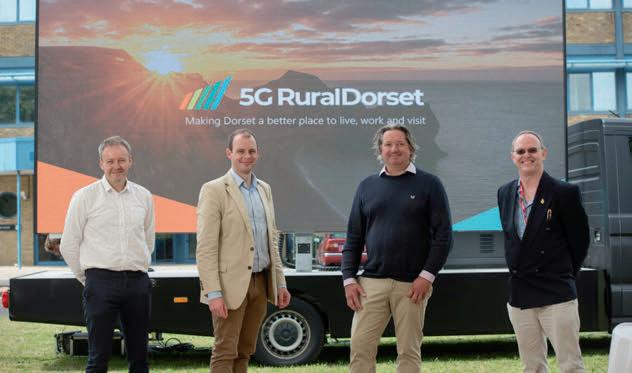
nitrogen is arable production’s biggest liability(L to R) Name, Former Minister Matt Warman, 5G Testbeds and Trials Director Ian Smith and Dave happ from 5G Rural Dorset met to watch Bob, Dick and Wilma
confirmed.
Millimetre wave technology uses extremely high frequencies never used before for consumer mobile networks. Until recently microwave frequencies were only for backhaul, and scorned as a consumer technology. But recent lab advances in antennae and semiconductors made it plausible, and now it works, with initial deployments by the Verizon network in the USA
Increased capacity offered by high frequency 5G millimetre wave will allow the robots to upload the huge amount of data they will be gathering in real time.
Centralised processing will allow a fleet of robots to learn from each other by taking advantage of the complete dataset, rather than operating in isolation. Multiple robots will be able to communicate and work in parallel, which saves time and takes advantage of good weather windows. It also reduces the processing capabilities required by an individual robot, thereby reducing the cost of each unit and increasing its battery life.
Dave Happy, Security, Spectrum and Collaboration Lead for 5G RuralDorset, said of the work: “Qualcomm is the world’s leading wireless technology innovator. We are delighted to be working with the company to assess the capabilities of its latest Snapdragon and 5G Modem-RF Systems during our R&D testbed in rural Dorset. If people thought that rural areas only needed spectrum coverage, and not the capacity offered by higher frequencies, these trials will hopefully put that myth to bed.”
From Qualcomm’s point of view, the forward thinking, innovative use cases that make up the Future of Food research area, led by Wessex Internet, present them with access to a wide-scale real-world agriculture test bed in order to grow into new global markets.
mmWave has appeal for deployments beyond city centres, “5G mmWave can also deliver high-capacity wireless broadband access to … suburban, and rural settings. 5GRuralDorset will demonstrate how 5G mmWave can bring smart agriculture capabilities to remote farms.”
The farming trials in England’s fields provide a great example of how mobile communications can make a practical difference, and change work practices. The aim is to gather 1,000 samples per field. The laser scanning being used gathers around 13 Mbps, which shouldn’t tax an urban 4G connection.
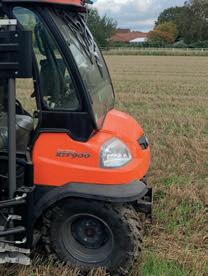


This is a constant stream, however. So the goal is to have a buggy doing the sampling, with the data being sent to the cloud for analysis and then have the profile for fertilising downloaded into a following tractor which dynamically alters the chemical balance as it moves.
To do this will require a reliably fast connection for both the buggy and the sprayer. There are alternative methods to using 5G. WiFi doesn’t have the range to cover these rural areas. A proprietary technology called Lightbridge from the Chinese drone maker DJI provides the range, but DJI was blacklisted by the US Department of Commerce last year, so its use wouldn’t exactly be consistent with Government requirements for a more secure supply chain. One answer might be to scan, save the data to a memory stick, take it to a place with broadband, upload the data, then download information for the tractor and return the next day. But in practice this has been found a difficult solution to deploy.
use of expensive sampling hardware. There is a practical aspect too. Farms are tough environments; memory sticks get lost and damaged.
The solution needs more than the data speed of 5G, it needs the reliability. In time other 5G technologies may be implemented. Release 16 positioning could give improved accuracy for the locations of the samples and Mobile Edge Computing could see the soil analysis processing done on the farm. The 5G infrastructure also opens up the path to using autonomous buggies and sprayers, extending the working day by eliminating the need for breaks and allowing working through the night. And of course it is valuable for other farm uses from livestock tracking to guarding against equipment theft and tourism. People might want to go back to basics and live in a tent but they still want to stream Strictly.

In both cases the potential extends far beyond today’s trials. For example, Map of Ag collects a wide range of farm data from record systems, from milking machines to variable rate seed spreaders, to weather stations. The data platform allows farmers to control and be better informed when making farming and business decisions. All of this data is easier to access and process if the connectivity is good. Having a mobile network also encourages more frequent, seasonal surveys.
Producing better crops cheaper has always been an imperative for farmers around the world, but there is an added export potential now that nitrates have become an international concern. Reducing nitrogen and carbon dioxide production has increased in profile. What has started in rural Wiltshire has the opportunity to go global, and perhaps beyond, with a little help from a robot friend on Mars.
Wassim

how
Chourbaji, Qualcomm’s Senior Vice President of Government Affairs stressedA connected solution would allow several fields a day to be covered. A disconnected system means several days a field. This is poor
5gruraldorset.org/projects/future-of-food/

To the general public, 5G is simply a new symbol in the top corner of their shiny new handset representing Enhanced Mobile Broadband (eMBB), which most of us understand and expect. But what about the other promises—the Internet of Things, Massive Machine Type Communications (mMTC) and the pinnacle, Ultra Reliable Low Latency Communications (URLLC)— that operators and enterprises are betting on to enable new monetising opportunities.
5G deployment is not a simple radio upgrade, but a complete change of topology. It demands major changes across the network to support 5G Standalone (SA), to enable myriad new 5G services, many of them yet to be imagined.
Take as examples, mission critical applications such as remote surgery, or fully self-driving cars, these “verticals” will place an everincreasing load on underlying networks and are exponentially more demanding than mobile video streaming and mobile data from the 4G and 3G eras.
If you manage a mobile operator, in what is an excruciatingly competitive environment, bidding to build a large campus or private network for a new hyper-scale factory, you would not consider deploying an underpinning network that had not been adequately stress-tested. You would be very keen to understand the new methods of operating procedures (MOPs) to confirm that your colleagues were assuring all aspects of the network build-out and turn-up were being done correctly.
For example, 5G relies on higher spectrum frequencies, mid-band: 1-6 GHz (CBRS and C-Band) and
high-bands: > 24GHz (mm-wave) for its greater speed and capacity, but that increases cell density. New massive MIMO antenna beamforming enables that extra capacity, sending multiple data streams, one per UE, using the same time-frequency resources. O-RAN is delivering flexible and distributed cloud-native Radio Networks. This complexity brings major challenges in the radio frequency (RF) domain. Furthermore, the fundamental shift from the frequency domain to Time Division Duplexing (TDD) brings all manner of synchronisation problems – 5G is much more complex than the previous Gs.
Because networks are undergoing unprecedented densification at a staggering speed to enable 5G, failure to test adequately could have catastrophic and costly consequences.
The following tests are essential to get to problem-free 5G:
• Measurements at the cell sites, such as coaxial cable verification, return loss, VSWR, cable loss, distance-to-fault, and insertion gain/loss
• Antenna alignment testing, now much more important in this new paradigm
• Fibre cable verification, inspection, optical power measurements and fibre verification with an OTDR
• Real-time spectrum and interference analysis, including gated-sweep spectrum and blind-scanning
• Signal analysis over-the-air for 4G/LTE and 5GNR including NSA / DSS modes and coverage testing

• RF over CPRI testing up to Line Rate 8 (10.1Gbps) and
• Coverage mapping for QoS and EMF testing, both spectrum and 5G beam-based methods all need to happen to ensure not just a successful launch, but problem free growth.
Testing 5G is significantly more complex than testing earlier mobiie technologies. Many tasks which could previously have been done in a lab now have to be performed in the field. Only through gathering real measurements can network perfomance be optimised.
VIAVI has supported operators globally for 100 years. We see that as new 5G networks are being deployed, many of these essential steps are being ignored. A simple check with a 5G enabled handset to ‘prove’ it is working is not enough. It’s not just at the cell sites where advanced field-testing is required. The 5G lifecycle means efficient lab verification of network equipment, capacity, and throughput, through to monitoring and service assurance for smooth deployment and timely launch of any new 5G network or service. Built-in network equipment alarms are helpful, but knowing fault cause, precise location and who or what services are affected makes a real difference in the proper uptake of a newly launched service— in other words, delivering on the promise of 5G.
To find out more about how to get to problem free 5G, please visit https:// go.viavisolutions.com/5g-bootcamp-ii, where you can view a short series of video conversations with Prof. Andy Sutton, BT and Julie Snell, Chair of the Scottish 5G Centre, who discuss these ideas in more detail.

If you asked five people about the promise of 5G, you’d hear at least as many answers. As a UK5G Innovation Briefing reader, you’d do better than most. “What a difference a G makes,” Paul Gowans, Director of Mobile and Enterprise, VIAVI Solutions.
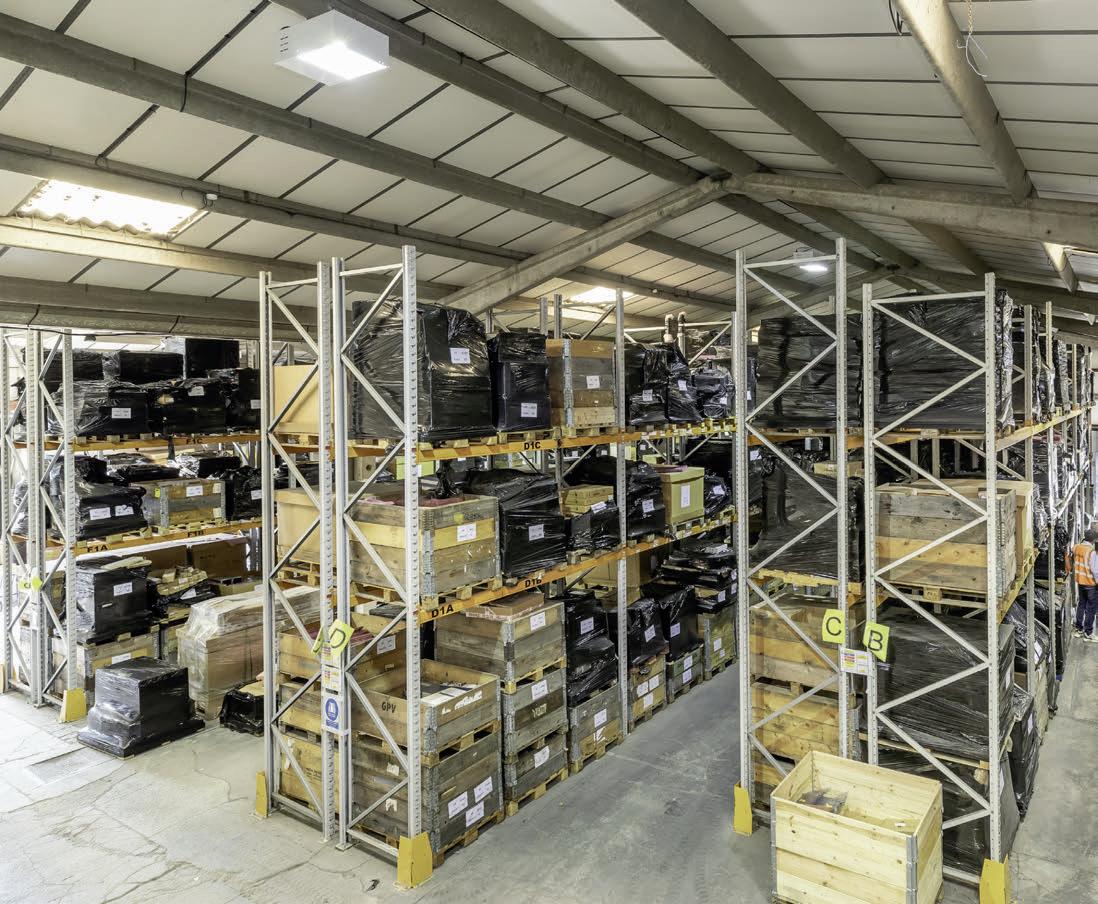
Making good use of the things that we find is the mission for DTC Telecom which puts the ECO into Telecoms.

SPEAKING TO JAMES NORDEN at DTC telecom is unlike a conversation with anyone else in IT. While others might talk about megabytes and megahertz, he talks about tonnes. “We pulled 170 tonnes of equipment out of one customer; it was running but no traffic was going through it. We saved them £2m a year on electricity”.
DTC’s main business is decommissioning telecoms networks. The equipment it extracts from the operator may be sold as a whole network to another telco, or piecemeal as individual pieces of equipment. Or broken down as spares or for recycling. The aim is to find value in everything, and even if parts don’t have a value, to ensure that they are disposed of in an environmentally responsible way.
“There are three aspects to the business,” Norden explains. “Aftermarket sales, which comprises of legacy equipment supply and repairs. Technical Services; which includes consultancy, technical engineering and project management. Reverse Logistics; equipment recovery from all over the world, complex logistics, monetisation of the material and recycling.” The aftermarket sales side of the business allows companies to beef up their telecommunications and datacentre infrastructure without paying the new retail price for the equipment. Not all of the equipment DTC sells is used – some will have been spares that were kept and never installed.
Some will be end of line kit from manufacturers inventory and some, like a lot of Huawei, will have been delivered to operators, can’t be installed and is now looking for a new home overseas. The latter is comprised of base stations, antennas, microwave equipment, and complete fixed networks.

The global chip shortage has hit the industry, and caused long lead times on orders for new equipment. “Some of the OEMs are quoting over a year and out to supply parts”, says Norden.


This has drawn companies who would never have thought of purchasing second-hand equipment to knock on DTC’s door.
Norden is surprised by how new much of the equipment DTC extracts is. While much of the technology ages badly, apparatus such as racking systems, power supplies and cooling, that has breen kept in a pristine data centre often emerges in excellent condition. Norden laments the wastage.
“We pulled 250 perfect racks out of a bank. We could sell some of them, but most went for aluminium recycling”, he notes. He says that the DTC warehouses, located not far from Oxford, store equipment that would have cost billions of pounds when new.
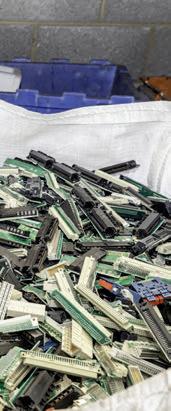



DTC’s legacy business allows companies to keep their networks running long after the original manufacturer has stopped supporting their hardware – much like a shop which sells typewriter ribbons, or reel to reel tapes. The recent “Organising for Digital Delivery” document, an independent report commissioned by the Cabinet Office and DCMS, reported that as much as half of government’s £4.7bn IT spending is directed to keeping old systems alive. For some businesses, the ability to keep their systems supplied with spares is a lifeline, and that’s where the repairs come in. DTC-
Telecom will also fix ancient technology, giving it a longer lease of life. Some clients use DTC for predictive sourcing, being on the lookout for spares which may be needed in the future.


“There are stories about circuits going down and people paying £10,000 or £20,000 pounds for a network card that would otherwise be available for £1,200, except there was only one available on that given day. We might have an arrangement with a supplier where every time they can supply us a card at less than $250 we’ll buy it rather than going to the market when it’s needed,” says Norden.
Hayley Hayward, DTC telecom’s Global Account Manager is the person charged with locating equipment for clients and finding clients for equipment, “I’ve got one customer who is after some test kit and am looking to place some esoteric parts such as a Ciena NTK539UE 100Gb optical networking card which is used to drive subsea cables. New, it has a list price of over $1m”.

DTC has some sensitive geo-political issues to consider. The company is removing Nokia, Ericsson and Siemens equipment from installations in China, equipment which will be superseded by Huawei kit. It’s also extracting Huawei equipment from networks in Western countries, to be replaced with Scandinavian apparatus. And this can lead to confusion.
When new equipment goes on site, it’s unpacked, and normally, the old kit is put back in the boxes used to transport the new. When those new boxes with the old parts arrive, they could easily confuse the DTC warehouse. The company is savvy to this, and Norden points out that using the packaging ensures that the second-hand equipment arrives in good shape. He says that they encourage the re-use of the packaging, to ensure that it’s either reused or disposed of ethically by DTC Telecom

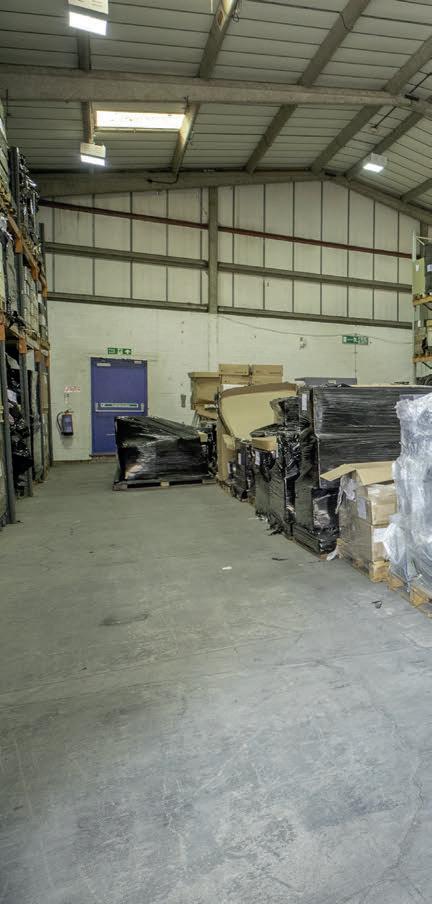

The warehouses at DTC-Telecom are huge. The tonnes Norden speaks of are here: palletised and stacked, cabinets, switches and cells. As we wander through, some engineers are assembling an order for a customer: finding cables for equipment which is being shipped out to Turkey. Our visit triggers a minor panic as the photographer’s flash in the warehouse causes a moment of alarm.
In the warehouse you can sense opportunity. If only the equipment could find a home, it could be alive again. It somehow doesn’t feel right that it’s lying dormant and not living out its purpose. Peering at the labels we find lots of Ericsson 2G, 3G and 4G equipment, all perfectly good but superseded by newer generations.
OEMs are quoting over a year to supply new parts. If we’ve recovered them we’ve got them on the shelfHAYLEY HAYWARD (Below left) DTC telecom is building a full 4G/5G core to test incoming equipment.
AND THEN THERE IS THE PART OF the estate where electronics go to die. Men with the skill of Fugu chefs disassemble unsaleable equipment to extract tiny amounts of gold and copper, and place the parts in huge buckets.
Recycling gold is often cited as the reason recovery businesses thrive but Norden explains that the quantity is minimal. It may take three years to have enough to merit processing. Aluminium and stainless steel are retrieved in larger quantities, to be sent off to Sheffield for re-smelting.
We walk back to the main building past a couple of phone boxes with the logos which would be familiar to anyone holidaying in the Caribbean. Norden explains that shipping
them back is a balance of ecology and economics. It’s not financially the right thing to do, as they have next to no value, but if they had been left, they would probably have gone to landfill. DTC prefers to leave the sites that it’s stripped out as clean as it can.
The contrast as we enter the offices is striking. This is home to a row of 19-inch racks filled with equipment, and humming away. It’s a live datacentre, and it’s where DTC evaluates and tests the equipment. This building operates a full private network, thanks to the help of Telco Electronics, one of the participants in the DCMS Rural Connected Communities project. This network does not provide any coverage – it uses dummy loads rather than full antennas – but this allows DTC
to make sure that the equipment that it’s received is working. Equipment sourced through the used equipment marketplace is expected to arrive tested with a report. If it’s come from an end user, such as a mobile network, the pricing reflects a perceived failure rate, and so DTC will take it on consignment. It then acts as an agent on a revenue share agreement to sell it on, rather than buying it in. Even recycling gives the seller a good rate of return.
Buying telecoms equipment by the tonne might be an odd metric, but DTC makes it feel not just sensible, but virtuous. While much of technology is about looking to the future, it’s reassuring to know that looking after the technology of the past also finds a place.
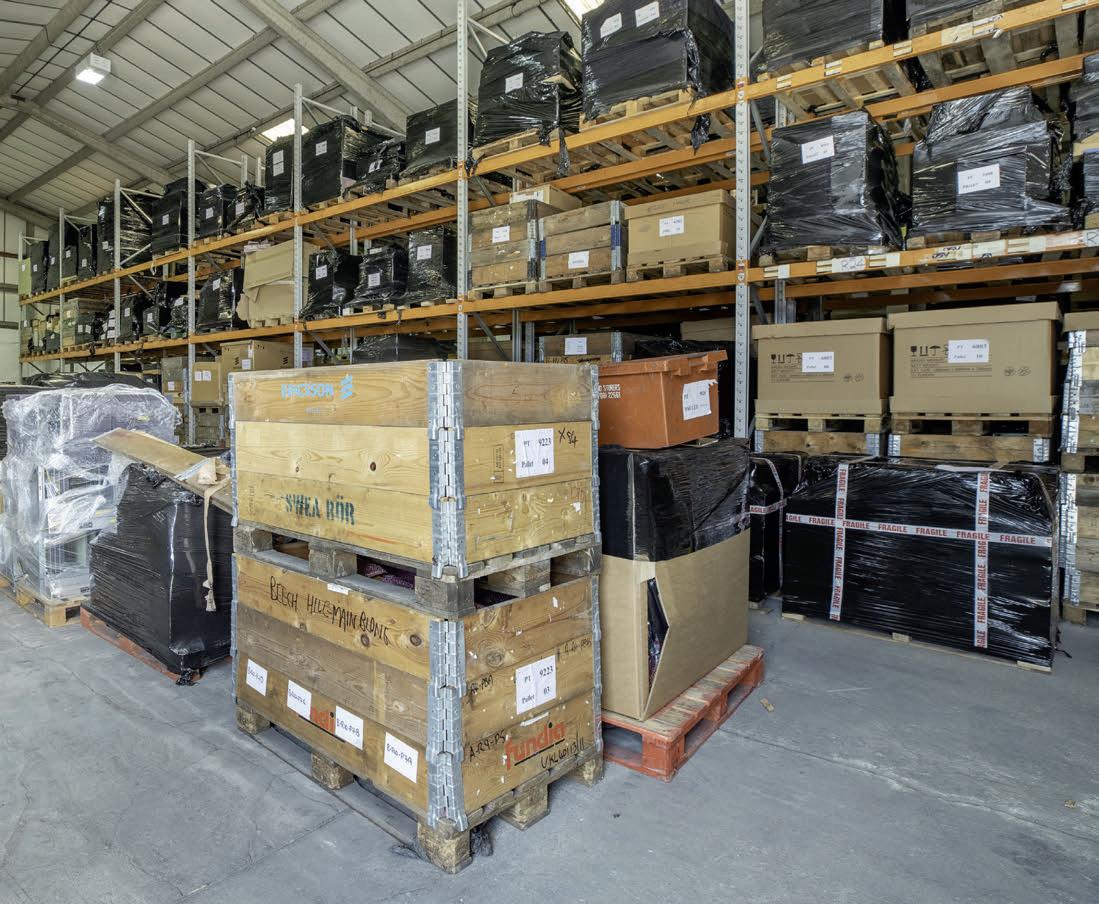
Previous generations of technology have looked at e ciency of spectrum, now energy and social responsibility are to the fore as 5G looks to quadruple data tra c without increasing energy consumption.
Building a better world is a common goal shared by communications companies, but looking after the one we have is even more important.
As a technology 5G remains on track to become the fastest adopted mobile generation in history with subscriptions predicted to exceed 3.5 billion by the end of 2026. There is no doubt that whole populations and industries will become more connected over the next decade but it’s down to the mobile industry to rise to the challenge of ensuring our connected future is a sustainable one.
Ericsson is committed to delivering mobile connectivity for positive change and is already playing its part by setting a carbon neutral target for its own operations by 2030. Up to 5,500 fleet vehicles are being switched to those running on electric power, renewable energy is being used to power operations, and there are reductions in product transportation and business travel that have helped them reduce emissions by 57 percent compared to 2016, and by 71 percent in comparison to 2012.
The company has also set a target for high emitting and strategic suppliers to set their own climate targets – Ericsson was one of the founders of the 1.5°C Supply Chain Leaders initiative.
But it’s the use phase, rather than the manufacturing or disposal of equipment that is having the biggest impact on our planet. A base station is powered permanently for around 10 years, which results typically in at least 85 percent of its carbon footprint occurring during operation.
With each generation of mobile phone technology, we’ve seen an increase in the amount of energy the network has required. Ericsson’s R&D has worked to improve the e ciency of its technology so that while 5G may quadruple the throughput of 4G it will use no more power, indeed 5G can be up to 90 percent more e cient than 4G in terms of energy consumption per unit of tra c.
The aim of this work is something Ericsson calls “Breaking the energy curve”, this employs techniques such as using AI to operate site infrastructure proactively. Erik Ekudden, Senior VP, CTO and Head of Group Function Technology explains “Thanks to the 5G standard and our development e orts, it is possible to significantly reduce energy consumption. 5G, which is the most energy-aware standard, will allow the mobile system to use smart sleep modes more e ectively and extend coverage by using lower bands while increasing capacity and speed with carrier aggregation. Fast and e ective data transmission enables the system to return to a low-load state faster.”
One of the products to have come out of Ericsson’s focus on sustainability is the antenna-integrated radio solution AIR 3227. The company has worked with Vodafone to address power consumption with more energy e cient base stations. The site seen in the main image here is hosted on Vodafone’s London HQ, known as “The Speechmark”. The new radio saw daily network energy consumption decrease by an average of 43 percent in direct comparison to previous generations of radio technology, and as
Vodafone and Ericsson have completed the first deployment of a new 5G radio that saw energy consumption decrease by a daily average of 43%, and as much as 55% at o -peak times in Central London.


much as 55 percent at o -peak times. The radio is also 51 percent lighter than earlier models which means lighter weight masts can be used, resulting in easier network upgrades and less time on site. 1,500 of the new radios will now be deployed across Vodafone’s network by April 2022.
Andrea Dona, Chief Network O cer, Vodafone UK, says: “Our strategy is simple; turn o anything we don’t need, replace legacy equipment with up-to-date alternatives and use the most energy e cient options available. The success of this trial allows us to explore new ways we can more e ectively manage the energy consumption of our network with our partner Ericsson. There is no silver bullet to manage our network energy consumption - it is about putting sustainability at the heart of every decision and adding up all the small gains to make a material di erence.”

Energy savings are being made on high-capacity cells too, Ericsson recently added the AIR 3268 to its Massive MIMO portfolio. With 200W output power, 32 transceivers and passive cooling the new device only weighs 12kg yet is 10 percent more energy-efficient. The AIR 3268 introduces Massive MIMO Deep Sleep. This software upgrade can save up to 70 percent output power during periods of low traffic load, equalling up to 1.2 MWh yearly savings per site. It is the lightest and smallest Massive MIMO radio in the industry.
By modernizing the network with the latest technology and replacing old equipment, operators have found they can upgrade their networks to generate more revenue from new services and at the same time, create significant energy savings.

Previous deployments of mobile
generations were often managed by adding new equipment while keeping existing systems in place. But upgrading and updating even low-traffic areas can yield a payback period of less than three years for energy savings alone.
The ICT sector itself accounts for only 1.4 per cent of global greenhouse gases, however estimates suggest it can enable a 15 per cent reduction in other sectors, so you can see why companies like Ericsson are fully focused on pioneering a sustainable future.
From first connecting people, technology will now connect everything and it’s through 5G being the biggest ever platform for innovation that whole new industries and sectors can reap the extra rewards for our planet.
Björn Odenhammar, CTO Networks & Managed Services, for Ericsson in the UK and Ireland spoke recently at a Tech UK event about increasing the efficiency of port operations: “5G is good for business as it helps enterprise partners save money through efficiency gains, but even more important is that it is also good for the environment. The deployment of 5G in Livorno at one port terminal operation can reduce emissions by 8 percent.”
This will be music to the ears of Felixstowe and Belfast who have begun to integrate 5G into their operations as part of the 5G Testbeds and Trials Programme. Through the use of technologies such as Artificial Intelligence, the Internet of Things and Extended Reality, enterprises can build all-manner of innovation to drive down costs, energy usage, emissions, waste and mitigate climate change.
Perhaps the most obvious use was during the COVID-19 pandemic where video conferencing helped to shrink distance and simulate physical presence, cutting down on unnecessary travel and helping lots of sectors connect with customers, patients and clients differently.
Technology can also facilitate the transition to cleaner energy, including smart grids and smart meters, using 5G to collect real time data and create virtualised and decentralised “intelligent” energy networks, making today’s highly centralised and inefficient systems seem a thing of the past.
Sustainability is a continuous journey, and it is one of purpose.
While there are goals, they are not destinations. The journey will continue beyond them.
As a global technology leader Ericsson’s newly launched company purpose is targeted towards creating the connections that will make the unimaginable possible. Its vision includes a world where limitless connectivity improves lives, redefines business and pioneers a sustainable future.

It is certainly an exciting time to capture these emerging opportunities and the scale of the upcoming technology shift is going to unleash an entirely new wave of innovation that means the responsibility will be upon all of us to engage and address some of the planet’s most pressing issues.
For more information about Ericsson in the UK visit www.ericsson.co.uk
FRANC, OR THE FUTURE RAN Competition, takes UK policy onto new ground.
While the UK’s existing testbeds and trials programme has helped stimulate the demand side of 5G, the new initiative is a focused intervention on the supply side. The programme is much more about leading-edge engineering.
FRANC is intended to stimulate a number of companies which officials hope will grow into alterative radio access network (RAN) suppliers, supplementing the established industry giants Ericsson and Nokia
The competition has a subtle history – and is really a story of how the lack of a diversified supply chain has posed a threat to the resilience of our telecoms critical national infrastructure
The paper trail begins with the Future Telecoms Infrastructure Review [http://cwjp. co.uk/ftir] published in July 2018, which set out how to achieve the targets for UK full fibre and 5G availability. This was followed up a year later by the UK Telecoms Supply Chain Rev iew Report [http://cwjp.co.uk/ tscrr], which addressed new concerns about how that might not be achieved.
The supply chain review report was the first to highlight the need for a wider selection of telecoms vendors. It looked at three questions: How should we incentivise telecoms operators to improve security standards and practices in 5G and full fibre networks? How should we address the security challenges posed by vendors? And how can we create sustainable diversity in the telecoms supply chain?
The review recommended that the
government assess the risks posed by vendors to network security and resilience, and apply proportionate and targeted controls to mitigate those risks.
Parliament then took up the gauntlet and the House of Commons Science and Select Committee reported in January this year http://cwjp.co.uk/5MDA, addressing the issue of supply chain diversity directly. Ruing that governments had not addressed the issue before, leading to a situation where mobile networks faced a limited choice of vendors, the Committee made some proposals to address the situation
The Committee wanted the government to both work with vendors such as Samsung which didn’t have a strong presence in the UK, and
stimulate new vendors. The report accepted that one of the reasons that the operators were tied to existing vendors was the need to support 2G and 3G and encouraged rapid upgrades to 4G and 5G. More specifically it recommended a “transitioning away from 2G and 3G technologies”. The report proposed that Government should back new testing facilities, so helping new entrants gain a foothold in the UK market.
The report recommended that “the Government should identify opportunities to support new market entrants scale their production by supporting the deployment of novel small-scale 5G deployments.”
It should also “provide details of planned measures to support diversification and expand 5G coverage in its Industrial Strategy.” The Committee also recommended that the government use regulation to force mobile network operators to buy from nonmainstream vendors, and re-examine the business rate relief on mast deployments.
The main recommendation however was that the government adopt a coherent, response to 5G: that the working with operators, funding innovation, ensuring national security and building testing facilities were all part of a national strategy for critical and emerging technologies.
The House of Commons Science and Select Committee report has also to be seen in the context of the 5G Supply Chain Diversification Strategy (http://cwjp.co. uk/5GSCDS). Published in November 2020, this concluded that the risk of national dependence on a small number of suppliers is most pronounced in the mobile and fixed access networks, but also took into consideration the need for diversity in other elements of the mobile network, and the impact of increasing reliance on software and virtualisation of networks.
The strategy focused on the 5G - rather than legacy - network where the risk of market consolidation is most pronounced. It set out measures which looked to accelerate diversification within the mobile access network supply chain.
The Committee noted that as the UK only accounts for two percent of the vendors’ revenue it would be impossible to drive change on a global scale.
The 5G Supply Chain Diversification Strategy details a multifaceted approach across three strands of activity which balance greater network resilience in the immediate future, with bold and ambitious interventions
to open up and grow the market into the future. The three strands are greater support for Ericsson and Nokia, attracting new suppliers to the UK market, and accelerating open interface solutions.
In its response, the Government (http:// cwjp.co.uk/5MDArespon) outlined what it would do.
Much of this involved more research, such as understanding operators roadmaps for shutting down 3G and 2G. In parallel, DCMS had established the Telecoms Diversification Taskforce under the leadership of Lord Ian Livingston of Parkhead, formerly chief executive of BT. Its report http://cwjp.co.uk/ tdt is essential reading for anyone looking to understand the direction government is taking in open systems and supply chain diversity.
There is a mixture of pragmatism on timescale and control. The Taskforce recommended that the Government should seek commitments from the four UK mobile network operators on 5G supplier diversity and open architecture adoption.
“This should be on a long timescale –perhaps five to ten years and recognise that individual operators will have their own considerations as they develop plans for 5G deployment and the replacement of Huawei equipment in line with the position set out by the Government. The Government’s objective must be to have the operators adopt and publish their supplier diversity and open architecture roadmaps,” the Taskforce report concluded.
THE TASKFORCE SPECIFICALLY recommended a “challenge-led fund to accelerate suppliers’ product development for Open RAN in line with a collective set of performance requirements for UK operators,” and FRANC was the first instance of this It acknowledged that to address the requirement for competition and service differentiation between operators, “additional investment in and tailoring of solutions over and above the UK’s basic requirements” would be needed. To streamline adoption, the
Government should ensure “that new suppliers have the funding to perform the necessary R&D to meet the operators’ performance requirements.”
Nine technology areas were identified for further research. These encompass technologies which will be key to future telecom networks, and where there is potential for the UK to be globally competitive – in other words, there was some export potential. The Taskforce noted that delivering on these recommendations will require sustained investment and coordination across government and the telecoms sector as a whole.
These nine priorities can broadly be categorised into three areas.
The first is Telecom-specific hardware and software solutions which are core telecom functions. These are listed as synchronised networking, software defined and selforganising Open RAN, software defined open networking and cloud-based solutions; and end-to-end networks including convergence across different network types, such as IoT, cellular, optical, satellite, and computing.
The second area can be thought of as ‘cross-cutting’ technologies that will play an increasingly important role in the design and operation of telecoms networks, such as data analytics and AI. The third encompasses socio-political issues such as privacy and trust, and environmental goals such as Net Zero.
The work of the Telecoms Diversification Taskforce has sired a new advisory board to build on what has been started, and that is being run by Simon Blagden.
ACCORDING TO SIMON
Blagden’s father, “he sells telephones”. But there’s more to the new head of the Supply Chain Diversification Advisory Council than that. The independent Council was set up by the government to look at how to protect British industry and the economy from any problems which may arise from there being only two equipment suppliers to our mobile networks.
Blagden has been passed the baton by Lord Ian Livingston, who ran the Telecoms Diversification Taskforce, a group which included leaders from many parts of the industry to look at the specific problems faced by the telecoms industry born out of the demise of the British telecommunications manufacturing industry. Where once there was GEC, Plessey, Marconi, STC, Racal, and more, today there are small interesting players such as Blu Wireless, ip.access, cellXica and Cablefree. But even when combined, these don’t match the scale of the companies we’ve lost.
Blagden is charged with understanding the problem, analysing the strengths and weaknesses of the British technology ecosystem, and advising government on what to do about it. And he is well-placed to do it. He worked at GEC-Plessey, which became Marconi, as an international sales manager.
“They sent me off all over the world with traveller ’s cheques to try and sell digital exchanges,” he told us. Success at this was followed by various roles including country manager of Bulgaria. “It was really exciting because it was at the time when the Iron Curtain was coming down. It was like being in a James Bond film.”
His roles after that, as CEO of the German telecoms copper and fibre company Quante extended his international experience. After a period in defence supply in South Africa he returned to the UK and joined Fujitsu as a non-exec chairman of telecoms.

“Just for two or three years, to help them sort out with some specific tasks,” he says. That assignment lasted almost 15 years.
“And I thoroughly enjoyed that. Fujitsu UK was a big beast, or is a big beast; about two and a half billion turnover in the UK, and half
of that with the UK government, telecoms and IT,” he recalls. During his time in telecoms at Fujitsu he worked on supplying broadband equipment to support rural rollout.
As Blagden picks up the baton from Lord Livingston “I’ve known Ian Livingston before he was even at BT, which is a long time. And I had several chats with him during the period he was running this taskforce, and was therefore reasonably informed about what the role was of the taskforce.” But he was taken aback when it was suggested he take it on to the next stage.
“Out of the blue one day, I got a call from the then digital minister, Matt Warman, again who I’ve known since he was first an MP, and
asked if I would like to carry on the role of the advisory council. I suppose it was like someone who gets surprised when they’re asked if they would like to be married and they had no idea it was coming.” It wasn’t a hard decision, he says.“ I thought what a really good opportunity this was for the UK, and I’d very much like to be a part of it.”
While Blagden is new to the role, he comes to it with a grounding in both telecoms and the work the taskforce has been doing. And he has opinions on the move to open systems, too.
“You have to start from the point of who pays for research and development. It’s a wonderful utopian world to believe that we can have open systems for everything, but companies driving technology forward need to own something at the end of it. If you’ve spent thousands of hours in research and
development, you expect at the end to have some return in value for it. It’s also the way companies are valued: the finance community bases value on a number of issues, one of them being intellectual property. Companies drive R&D down a certain path with an expectation at the end that there will be return on it.”
BLAGDEN IS PRAGMATIC ABOUT dealing with the situation where the only two vendors available to UK operators are Ericsson and Nokia.
“Any good Sergeant Major will tell you the first rule of survival is to completely accept the situation you’re in, or you’re going to die. We are where we are. What we need to do is look forward and how we’re
When looking at security and resilience the supply chain briefs do so from three different angles: Network Security, Resilience, and Timing and Synchronisation.
Network security is about making sure systems are not hacked. In November 2020, DCMS produced a New Telecoms Security Framework http://cwjp.co. uk/5gntsf. Changes were made to update the Telecommunications (Security) Bill. It brought in security duties for telecoms providers, added secondary legislation to detail specific security requirements that providers must meet and codes of practice to provide guidance on how, and to what timescale, certain telecoms providers should comply with their legal obligations. For example, it will set out the detailed measures that should be taken to segregate and control access to the areas of networks that process and manage customers’ data. The Bill gives Ofcom a new general duty to ensure that public telecoms providers comply with their telecoms security duties. This gives Ofcom a clear remit to work with the telecoms providers to improve their security and monitor their compliance.
The second level of security, which FRANC seeks to address, is supply chain security. What this means is the likelihood that whatever may happen in the event of a war or some other emergency, the UK could call on a domestic supply of secure mobile telecommunications equipment. Clearly, without a

microprocessor wafer fab, we will continue to be reliant on overseas suppliers; even many of the most important American-designed chips are manufactured by TSMC in Taiwan, potentially under threat from China. Geo-political issues of global security prompted increasing concerns about Huawei. The company went from unrestricted access to the market, to being allowed in just 35% of radio access networks, to zero with a timetable for removal.
The Livingston report particularly highlights the danger of all the MNOs using the same Nokia/Ericsson kit in one town or city. The concentration of the industry in just two suppliers is illustrated here: Three UK has opted for Nokia to provide its core network, while the other major MNOs are all using Ericsson for their cores.
Timing and synchronisation matter too. The Government fears that having left Galileo, the UK is reliant on Europeans, Americans or Russians for timing signals. This was identified by the Diversification Taskforce as an area where future domestic provision is likely to be critical to Critical National Infrastructure resilience. Networks don’t need to have the right time, they just need to have the same time throughout. All those stations must march to the same drumbeat and the report suggests that there should be funding for innovative solutions to ensure this is not reliant on systems where the UK may not have control.
You have to start from the point of who pays for R&D
going to put it right.” He sees the “putting it right” as an evolution “What is important is the companies that are already playing in the space; we need to be careful that we don’t destabilise them, because they’re key at the moment. And you can’t magic overnight a new supply chain.”
The new council chief wants to build a model to evolve a new way of doing things “The UK is extremely good at research and development and innovation. We have a lot of small companies born out of a few hugely intelligent people that develop things and develop technology. What we’re pretty bad at is industrialising that and bringing them to market. And often, things that are designed and invented in the UK end up being made somewhere else. The first realization is we can’t do this on our own. It’s going to require an international cooperation. That needs us to look at other markets.” To do this he is looking East. “Whether you voted for it or not with Brexit, we’re out of Europe,” Blagden reflects. India has caught his eye as a natural partner. “This has a huge number of technology graduates. Really bright, really intelligent intellectual capability. And they have the capability to rapidly industrialise and manufacture. What we should be doing is working with countries like that, that have the dynamism and aggressive innovation to move things forward, to drive our own requirements and standards in partnership with them so that we can benefit from that.”
Blagden wants the benefits of inward investment to be enjoyed more broadly. “The whole agenda of creating fairness in the country, the government calls it levelling up, to ensure that we don’t end up with just the Southeast of the UK being the place where everything is done”.
While he laments the loss of European subsidies and funding, Blagden sees freedom from competition laws as another bonus.
“It means we can focus properly where we want to develop areas of industry and put our funding in the places that are important to us.” That is not to say he doesn’t see European opportunities “Whilst the way that we work
with Europe is completely different now we’re out of it, we should consider they’re our closest trading friends, and there must be ways of working with them.”
The need for better connectivity, particularly in suburban areas has been highlighted by Covid accelerating the move to telecommuting. “But here’s the thing. Until every premises is connected finally by fibre, or by 5G, and you eliminate copper from the last mile, you’re bound to have bandwidth challenges based on distance away from an exchange.” He cautions, however, that manufacturing capacity limitations are pushing up the prices of fibre.
It will be the job of the Supply Chain Diversification Advisory Council to navigate the problems of the industry on fostering competition in the supply chain and suggest ways that government can alleviate them.

“The Council doesn’t have any decision making power,” Blagden cautions, “but it has great influence. Its membership of people drawn from industry, from academia, from the regulatory world, to ensure that we advise government on the best way of managing a diverse set of suppliers, a lot of international relationships, but also be aware of potential threat, both in supply chain resilience, but also in terms of the wider security threats. The reason the government wants the Council is to ensure that it’s in touch with what’s going on, and will listen to the advice that it’s given.”
The make-up of the Council is pretty much the same as the Telecoms Diversification Taskforce, with nearly all the previous members signed up to continue their roles “We have three or four other people we’re inviting. I’m a great believer that if we should have as small and efficient a board as possible, in this case it will be about a dozen people, but we can always call on other people for views and important information.”
Simon Blagden’s father may be wrong. His son doesn’t sell telephones, and he hasn’t for a long time, but his role throughout his career has been in ensuring that the pieces are in place to make sure that other people can. The Supply Chain Diversification Advisory Council is just another step along that road
The first realization is that we can’t do this on our own
The first programme to address supply chain diversity issues is underway. The Senior Interoperability and R&D Lead for Telecoms Diversification explains aims, process and timing.Photograph Stuart Berman
AFTER WEEKS AND WEEKS, sifting, assessing, and shortlisting, we’re close to achieving a milestone on the path we hope can create a more diverse telecoms market. The Future RAN Competition (which the team lovingly nicknamed ‘FRANC’ early on, and we made sure it stuck) called for projects that demonstrate innovative products and collaborations which need further research and development on their path to become commercial products. The winners receive a share of a £30 million pot. The response has been incredible - with companies across the UK and globally, big and small, submitting projects that truly have the potential to
revolutionise multi-vendor radio access network (RAN) equipment that our mobile operators rely on.
But to understand why FRANC is so important we need to see how we got here. Consolidation over generations of mobile technology has resulted in only three large companies supplying RAN hardware to UK mobile operators. The Telecoms Supply Chain Review report in 2019 had already called for the Government to help diversify the supply chain. And when the Government set out a solid
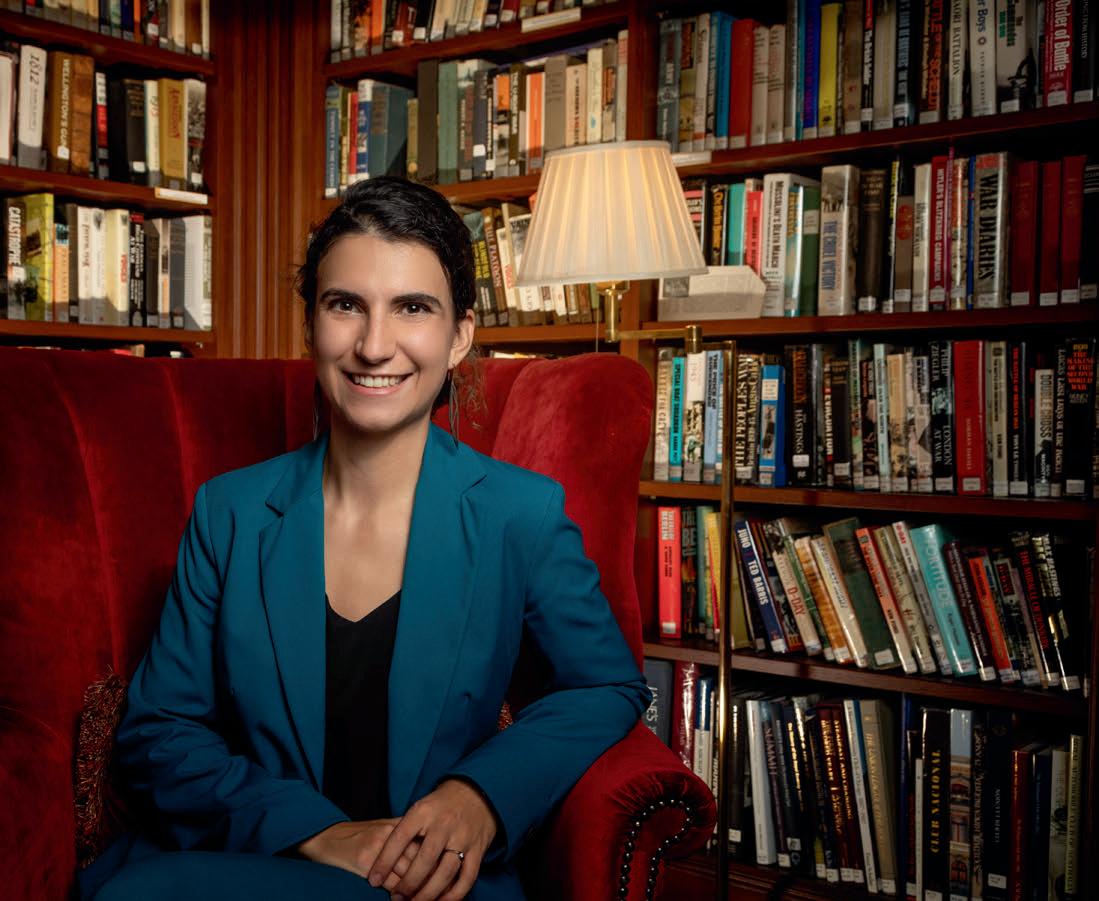
path to the complete removal of Huawei equipment from our 5G network by 2027 - that three became two. This lack of choice was bad for operators - but, critically, it presented a resilience risk to the UK’s telecoms critical national infrastructure. Hence, the need for the Government to step in. The Government responded to this by publishing its 5G Supply Chain Diversification Strategy in November last year.
“As part of establishing a holistic UK R&D ecosystem we will seek to support the incubation and scale-up of homegrown suppliers building
We will seek to support incubation and scale up of home grown suppliers
on the foundations that exist across our universities and in regional advanced technology hubs,” the Government promised.
In developing the Diversification Strategy, the central question was how to maintain competition in the market over the long-term. For example, simply mandating the introduction of a third RAN vendor might plug an immediate gap, but it would be heavyhanded intervention, and would risk giving the market a proverbial fish only for a day of diversification. We were keen to support a new, interoperable model that stimulates the market of suppliers. To labour the metaphor, we want to make fishing a national pastime.
This is becoming possible, as the various network functions become decoupled from large vertical integrated vendors with the emergence of Open RAN standards. Equipment interoperability is at the heart of our long-term vision for the market. When equipment can be sourced from multiple vendors and the buyer knows it can work with the minimum of fuss, competition flourishes. In addition, the buyer is less exposed to vendor lock-in. The Government’s Open RAN strategy is to make multi-vendor the default.
We presented this vision to the Telecoms Diversification Taskforce, chaired by Lord Livingston and comprising experts across industry and academia. The taskforce recommended investment in R&D, and identified five key areas that needed to be developed before open-interface deployments were technologically and commercially ready to be deployed at scale in the macro network. These were product development and engineering, systems integration, verification testing, performance improvements and network integration, and finally, maintenance services.
That’s where FRANC comes in. FRANC’s full name is the ‘Future RAN Competition: Diversifying the 5G Supply Chain’. FRANC was set up to stimulate the market for interoperable products, capitalising on the innovative ideas that were percolating across industry and supporting those that aligned with our diversification objectives. We prioritised
areas that were particular pinch-points for performance when compared to traditional, ‘closed’ deployments: things like power efficiency, spectrum management, software platforms, and systems integration. But we also wanted to be led by the market, and have been considering entries from across a range of Open RAN functions and components.
FRANC represents a departure from recent DCMS R&D initiatives embodied in the 5G Testbeds and Trials programme. While the previous programmes have looked at how 5G might be applied, this is something new: promoting component development and product engineering for a quite specific part of the mobile network. This has been daunting at times, but it has also been incredibly excitingas any exit from one’s comfort zone is.
OF COURSE, FRANC DOESN’T EXIST IN a vacuum, nor will it solve the problem of diversification on its own. It sits within a wider programme of diversifying the market, with the aim of removing obstacles in the path of potential new RAN suppliers. A complementary initiative is the SmartRAN Open Network Interoperability Centre, or SONIC Labs
Established in partnership with the Digital Catapult, this is a test centre for demonstrating and improving interoperability between equipment from different suppliers. For example, in North Wales, the NeutrORAN project is putting neutral host Open RAN equipment through its paces in a live, outdoor rural environment. A new UK Telecoms Lab is on track to open its doors in the autumn of 2022 – focusing on security and interoperability testing.
This is how the diversification picture looks today - but for the UK Government to feel confident that all five of the Taskforce’s areas for development are being addressed, there is still more to do. We’re exploring how we can boost and guide product development, as well as stimulating new R&D that wouldn’t happen without Government support - at least not in the next five years. To do this we are consulting with operators, suppliers, and systems integrators to understand the barriers and gaps that
need to be addressed in each of the five areas - as well as areas we may not have considered yet. The new Telecoms Supply Chain Diversification Advisory Council, chaired by Simon Blagden - a new external body that succeeds the Telecoms Diversification Taskforce - will inform our R&D strategy. Expect to see more competitions, funds, trials and events that are all aimed at creating a healthy, diverse and innovative supply market.
DCMS hopes that with backing for Open RAN, an ecosystem of suppliers is able to flourish. It demonstrates that the UK is open for business when it comes to telecoms investment, and that it’s the place to be for Open RAN research and product development. FRANC is one small step on this journey, but it’s a significant one.
The team and I have a hard task whittling down such a strong host of bidders to the winning few. It’s a testament to the appetite and creativity of the telecoms industry here in the UK, and a very promising start to delivering our diversification strategy.
The question of interoperability and longterm competition is a complex and multifaceted one, but the market knows that and is responding. I can’t wait to see what it says
Government’s OpenRAN strategyis multi-vendor






Delivering on the promise of 5G has meant fundamental changes across the entire network, meaning operators and their contractors have to change the way they turn-up and test.


































For more information visit: http://go.viavisolutions.com/5g-boot-camp-ii















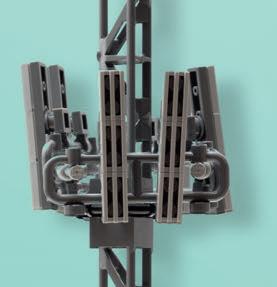









Putting together the parts for a mobile phone network is far from child’s play, but with open cohort of companies with the skills to take the basic building blocks and put together a telco.








If it stops working there must be one throat to choke or the market will revert to monolithic vendors














 Photography Stuart Berman
Photography Stuart Berman
IN THE 1980S, A THREAT emerged that to threatened to turn the market commercial IT upside down. For many years this had been dominated by a small number of giant systems vendors: companies like IBM and DEC produced expensive mini and mainframe computers, who also took care of the software and the service. The customer’s bill was large, but what the vertically integrated business empires produced was reliable and worked.
The threat came from the microprocessor, and what’s known today as COTS (commodity, off-the-shelf hardware). The operating system Unix was the unifying glue – Unix could run on anything. This was the ‘Open Systems’ movement and it was so persuasive, that every vendor, both old and new, pledged to sign up to it. Thanks to open interfaces, customers would be able to source then mix and match of hardware from different vendors, as these would be open systems compliant.
But what actually happened was a big mess. Systems turned out not to be very interchangeable. Legacy systems were rebranded as open systems too. It turned out that the a lot of features needed to be added to new Unix systems in order for them to be as robust as the proprietary legacy systems. And the integration costs exceeded the benefits of moving from a single vendor to many vendors. The failure of the industry to agree on true interoperability opened the door for Microsoft’s dominance in the early 1990s.
Today, something similar is happening to the telecoms equipment market. In place of mini computers, read proprietary telco equipment. In place of IBM and DEC, read Ericsson, Nokia and Huawei. In place of OpenSystems, read OpenRAN and neutral host. The economics is the same: COTS hardware and common standards will unbundle the vertical giants.

“The economical aspect means you open a new ecosystem of companies, including startups …You go from two to five companies in the whole world providing the equipment, to many more,” explains GUILLERMO PEDRAJA , VP and head of the UK Telco Market at Capgemini.
But will history repeat itself? Systems integrators are keenly aware of the history, and are determined it shouldn’t be a re-run of the Open Systems debacle.


“The cost savings of Open RAN must not be consumed by a system integrator, the cost of bringing a third party to bring it all together,” says YOGARAJAH GOPIKRISHNA , Head of the Global Centre of Excellence for OpenRAN at NEC. “We are very mindful of that.”


“Integration is all about taking responsibility but not swelling the bill,” agrees ABBEY ALIDOOSTI , CEO and founder of AWTG, a company that provides end to end network design and deployment.



Integrators bear a huge responsibility if the promise of cheaper interoperable hardware is to be fulfilled, says SIMON FLETCHER , CTO of Real Wireless and head of the International Engagement Working Group for UK 5G.
“A good supply of quality system integrators is critical to the success of Open RAN. It’s not just the availability of equipment, or the quality of the equipment - it’s getting the individual elements to work together in operational networks. That’s the integration task. And that’s a very large cost,” he says.
“If it stops working, there must be ‘one throat to choke’” says Fletcher. “If system integrators are not willing to put their neck on the block and take liability for the quality of the network, the market will fold back and become a single vendor again.”



The role systems integrators plays is to take on the many, varied roles previously undertaken by the monolithic vendors such as Nokia and Ericsson But as the market has evolved systems integration companies have followed it and as a result systems integrators come in different shapes and sizes. The UK5G Innovation Network’s Supplier Directory, which can be found at www.uk5g.org/5g-supplierdirectory, lists two categories: integrators for
traditional mobile network operators, and integrators for private networks. But within these sectors, there is a broad range of skills and capabilities.
“There are three types of players traditionally,” says Capgemini’s Pedraja. “The first are smaller vendors that were doing parts of the value chain in a traditional network, but decided to place a bet on this – these are the Tier 2 vendors”. Then he categorises the software startups – “OpenRAN is really about the “software-isation” and the virtualisation of the network”. “Then the third group, which is a very few experienced system integrators who can integrate different systems.”
Capgemini’s acquisition of the integrator Altran puts it in an enviable position. Altran was a founding member of the OpenRAN alliance and also its predecessor, the Facebook-backed TIP project, which sought to open up the market for telco equipment to commodity hardware makers.
LAST YEAR CAPGEMINI ACQUIRED Cambridge Consultants, the product development and technology consultancy firm, started in 1960 by three Cambridge University graduates, and that now boasts some 10,000 engineers and experts “Our background is in R&D and engineering, and we have also decided to go into development,” says Pedraja “We’ve been working with the standards body, ETSI, on the definition of the standards. We’ve gained the knowledge to develop our own software stack: a RAN-intelligent network controller, some units that go into radio equipment; and some frameworks for software integrators. Not every systems integrator has the capability or knowledge to do that.”
Capgemini can also boast breadth.

“The savings come from scale. If you’re replacing software, hardware, and the support from one vendor and if you just replace that with instead of a big block of seven smaller blocks, then you’re not saving much money,” argues Pedraja. “It’s only with scale where we get benefits.”

Pedraja cites the example of Altiostar, a relative newcomer and one of the leading lights in pioneering OpenRAN – like several vendors featured in this article, it was involved in the first functioning OpenRAN network for Rakuten Mobile.


“We develop their products, so we can optimise them when problems arise. How you react to problems is 50 per



cent of the integration costs. If you haven’t practiced that, you’re going to be less effective.”
End to end knowledge encompasses a broad range of skills, says Pedraja. These range from knowing how to create and integrate products, to the ability to do better blueprints the lab. “That’s part of being the modern system integrator in the open era.”
Not all integrators can do that – or try to. NEC is playing a leading role in diversifying the supply chain, with the opening of a 5G Centre of Excellence – a testbed - to put OpenRAN equipment through its paces, in conditions matching the real world.
The need for such a centre is because the new world of network presents a much more complicated picture to the buyer, as BAI’s Brendan O’Reilly explains with an example.
“The collaborative approach in a neutral host world means a site must work with three or four MNOs present. Traditionally, that would mean two or three vendors supplying the equipment. But in an OpenRAN world that could be up to 21 vendors. We need to ensure they work with the vendors they work with in the future.”
NEC is involved in Open RAN standards development too, but key is ensuring all parties are capable of interoperating.
“Prior to starting off any physical lab activity we are drilling down and making sure both ends of the wire are speaking the same language,” says NEC’s Yogarajah Gopikrishna.
“The systems integration we do is not just radio and hardware, we do everything from the core datacentre to the edge of network. There is also lot of work going on with various type of cloud platforms to make sure our solution gives choice to the operators,” says Gopikrishna.
“We look at vendors coming to our facilities when they are ready for that final polish, and final productisation,” he explains. “And that includes performance, reliability, stress testing these interfaces, to make sure that they’re carrier-grade, and they ready to go into an operator as a next step.”
THE LAB WILL INCLUDE performance testing equipment, such as load testers, channel simulators, emulators, and microwave test equipment to test beam patterns. The goal is to simulate real world conditions closely, so no nasty surprise arise when the network is deployed in the field.
“Right from the outset, a lot of the focus of this lab will mean automating, what we call the CICD, continuous integration continuous delivery process, where each component vendor can properly release,” says Gopikrishna
For Gopikrishna, there are three levels of integrators. Those who do some level of testing. Full stack integrators who develop software components, and full service integrators who bring everything necessary to replace the void left by Huawei.
“This includes field engineering, supply chain engineering such as ensuring there are












































capable of interoperating.
is also lot of work going on with various type of
release
Integration is all about taking responsibility but not swelling the bill
spares, lifecycle management, and maintaining field KPIs. The vision is to enable OpenRAN to be a drop-in replacement”.



Maintaining a long-term relationship ensures the customer isn’t caught out by supply chain changes. “MNOs are looking for a replacement for their incumbents it’s for the entire life cycle,” says Gopikrishna Conformance testing means “every time there’s a new release, this framework we are building would not only test the signalling and messaging across the interfaces but take it to the next level to ensure regulatory compliance.”
NEC’s 5G Centre will also promote and incubate start-ups and tech vendors, explains Gopikrishna.
“They must meet a certain standard. But to grow the ecosystems we can help incubate new innovators who are nearly there who need the final productisation expertise. We bring in more players to the ecosystem.”
Gopikrishna sees the need for integration as increasing, as it becomes more common for competing mobile networks to share the same equipment, and the 5G network roll out increases.
“5G is going to need a lot of densification in the C-Band and with millimetre wave,” he explains. Vendors will need to work out how to co-operate on neutral host sites. “So we are doing a lot of work involving the site,






connectivity, power - all the factors that influence sharing.”
AWTG’s Alidoosti cites an example of how integrators need to think about the problem comprehensively. “We deployed a network in which a customer wanted to bring the fibre connectivity to the base station on a lamp post. The supplier vendor did the connection. When we visited, we realised that when they have a problem: they would have to bring the whole base station down from the top of the lamp post, as the cable is going through the post. There’s no place to disconnect the cable,” he recalls. A more thoughtful supplier would have put a box and a splitter at the bottom, to allow a field engineer to run tests. As it was, they needed to close the road and hire a cherry picker whenever they needed to diagnose the network.
“The challenge is that a lot of systems integrators are just system integrators,” says Alidoosti. “Now you have a network and operate it. The problem why you are doing it - what is it for? What are the requirements?”
“The difficulty is when you bring different vendors - say ten or twenty different hardware companies, and twenty different software companies to make a great OpenRAN network, the problem is our responsibility is to ensure the performance of the network is stable, and that it complies with 3GPP and SCF (Small Cell Forum) specification.
“Previously if the customer had a problem there was one point of contact, for example Nokia. They’d do the trace, and one to two weeks later you’d locate find the issue. Now these interfaces multiply and imagine how complex it is.”
IN ANTICIPATION OF A MULTIVENDOR world, AWTG developed a service assurance platform, with the TM Forum, “that nobody had thought to do”.
“The Platform takes all the information from different components in the network so we know exactly where is the problem, where the delay is happening, where buffering is happening. We diagnose every part.”
“At AWTG we are trying to create a consortium to understand the challenges we need for the next two years with OpenRAN.”
“If a vendor wants to monitor their network today then you pay £170,000 a year for license and software. We bring something easy to use for a small network,” Alidoosti adds. “A real system integrator needs to be with the vendor with the end result and ensure everything is completed. Integration cost and deploy cost and operating cost has to be reduced or they cannot scale the network.”
Talking to systems integrators, software emerges as the key dramatic element in the story. The trend, described above, to supersede expensive single-vendor networking hardware with “COTS” or commodity hardware in initiatives such as OpenRAN is just one part of the changing landscape. But perhaps a more profound, parallel, trend is how the functions that network hardware once performed are being turned into software. And this software is also moving to the cloud.
“Virtualisation has been the biggest change in the last few years. The line gets more blurry all the time - software is winning that battle,” says Capgemini’s Pedraja

This brings new potential problems for integrators.
“The hardware platform integration is a very small challenge compared to the the end-toend software solution”, say Real Wireless’ Simon Fletcher. “No vendor’s equipment is the same specification-wise - there’s an awful lot is propriety functionality.”
How much? Fletcher estimates that the specification from the 3GPP “is just 10 per cent of the job.”

Specifically, standards bodies declare some features of a














































Today’sRAN and Core vendors will be up against new game changing suppliers suppliers
specification mandatory, and others optional. It will be up to integrators to discover whether that optional feature – and it’s one a customer needs - has actually been implemented.
Fletcher says he’s encouraged by the creation of facilities such as NEC interoperability labs. “That’s a step in the right direction with a lab,” he says. “You need load-testing capability. Some system integrators will do a few test cases under non-load conditions. But until you’ve loaded up the network with users and tested error handling, you’re nowhere close to having QA”.
He agrees that for a customer to be assured things will work, it can makes sense to stick around. “What you’ll find is commercially they make sense, they build the system and design it perhaps - we get involved in the buy side to direct the system integrator and design the system - a system is deployed and that system operator then becomes the integrator.”
He envisages Amazon, Microsoft and Google getting embedded in the architecture of the traditional MNOs. “That’s a new ecosystem of much more IT-oriented thinkers. They think much more about scale, and about plug and
play. That philosophy from the cloud may over time change the culture of the operators, and force standardisation over time - but it’s a double edged sword.
“Vendors who make money today from RAN and Core could find themselves up against a new segment of game changing suppliers and this would change the dynamics of the systems integrators as well. We could find more integrators coming from the software space.”
The leading candidate today for that prize is Mavenir. As networking and IT converges, we shouldn’t be surprised to find a software and cloud company move into the integration business, and Mavenir presents which boasts over 100 MNO customers for its messaging and voice software has moved into the space. Over the years the company hass acquired a range of competencies through mergers and acquisitions, so it now does everything except manufacture its own kit.
The company was born out of a three way merger then acquired Brocade for packet core, and IP-Access for legacy technologies
“The only thing we don’t do is transmission”
says TUSHAR DHAR , Director of Marketing Strategy and Business Development “We don’t manufacture our own hardware except for where we have our own radios.”
MAVENIR HAS HELPED
Vodafone in its pioneering Open RAN deployments in the UK. The company makes the case that a ‘software native’ vendor has a better grasp of COTS hardware. Mavenir has been able to provide a superset of the management systems for each portion (core, RAN) with a cloud platform. It’s part of the SONIC smart OpenRAN testing lab set up by DCMS and run by the Digital Catapult over three sites. “We’re already experienced enough to manage the end-to-end integration.”
For people building the networks to build applications, such as Bluemesh Solutions MD Richard Brooks, using the cloud vendors isn’t a hard sell. Blue Mesh is working with Three UK, Cambridge University on a DCMS-backed 5G:Create project to deploy remote control of the 31 quay side and 82 yard cranes at Felixstowe Port, a demanding environment. It’s
just the example that Government is keen to encourage to harness 5G to improve the competitiveness of the UK. “I’ve housed my lines of code in GCloud; I love the data as a service model. The free monthly layer allows me to experiment and test stuff.”


“What we want to be sure of is that the plumbing is reliable – that it’s secure and doesn’t leak - and we need to be sure we’re getting flexibility of contract. I don’t want to be married to be any one vendor for the next fifteen years,” he declares. “I want the flexibility to change if I’m not satisfied.”
The incentive is for the established vendor to maintain relationships.










Expect to see more vendors boasting their software credentials – and vendors holding onto their existing relationships, says Real’s Fletcher.


“The majority of the systems are sold on the hardware at almost cost price. The revenue earning for the big vendors is in the software licensing. That’s where they hold their IP.”
UK5G Innovation Network Supplier Directory www.uk5g.org/5g-supplier-directory

ANSWERING THE OFTEN asked three key questions about 5G is the key to unlocking the demand from vertical industries. The questions are: “What can I actually do with 5G?”, “How will it benefit me?” and “How do I go about getting it?” To do this, UK5G has launched a campaign working closely with DCMS to increase awareness and understanding of how 5G is relevant to individual industries.
Our first focus has been on creative industries, a sector that contributes £306 million to the UK’s GDP every day, and is increasingly going mobile. Intel’s 5G Economics of Entertainment report forecasts

that 5G could bring $1.3 trillion in new revenues to the media and entertainment industry globally by 2028, and that 57 per cent of global wireless media revenues will be generated using 5G by 2025.
The technology has the potential to transform the production and broadcast of content from sports, news and documentaries through to big-budget films. Covid-19 has already increased the number of remote performances, but 5G will help to embed this way of working for the long term, by reducing travel costs and permitting more sustainable ways of working. For example, the British band Coldplay has said it won’t tour again until shows can be done in a more environmentallyfriendly way. Instead of sending out production trucks or using in-stadium production rooms,
An important role for UK5G is educating industries beyond telecommunications about the benefits of the technology.
Vicki DeBlasi, Head of Marketing at UK5G explains the new campaigns which will do just this.
Tourism is likely to be worth over £257 billion to the UK economy by 2025
content can be streamed in high-definition video to production teams anywhere in the world, within minutes, meaning less travel, and lower carbon dioxide emissions. Brighton based 5G Festival test bed is the world’s first immersive hybrid festival, connecting artists across continents. It uses Mativision’s 360 immersive live streaming platform that makes use of increased bandwidth and ultra-low latency technology. Band members can collaborate from home, and don’t need to travel for gigs.
Spectators at live events from sports to the performing arts can have the experience enhanced through 5G. For example, Project Vista is delivering next-generation viewing experiences for event spectators by providing live multi-angle HD video streams and
interactive content from the event directly to devices in stadia. Beyond a stadium setting, the Connected Cowes project used 5G to stream real-time, virtual reality video from onboard yachts racing at events from Cowes Week this Summer. Designed to widen the appeal of the sport and enable immersive teaching experiences, the project took Cowes Week out of the water and onto the internet, with 5G.
And it’s not just the in-person experience that 5G is set to transform. The pandemic has forced arts organisations to get creative, with the Royal Opera House delivering the first
virtual reality opera during the lockdown. With 5G, we can expect to see ever richer, immersive and personalised experiences from the comfort of your own home. 5G Edge-XR, combining 5G networks and cloud graphics processing units, will allow audiences to view immersive sporting events from all angles across a broad range of devices including smartphones, tablets, televisions, augmented reality and virtual reality.
Tourism is another sector that contributes significantly to the UK economy, some £106 billion a year pre-pandemic. By 2025, the industry is anticipated to be worth over £257 billion, or around 10 per cent of the UK’s GDP, supporting 3.8 million jobs. With sustainability an ever-increasing imperative, the option of holidaying in the UK may become more popular. Here too, the Testbeds and Trials programme is helping the industry to explore 5G and find innovative ways to encourage the public to spend more and stay at sites for longer. The Eden Universe project is one example. It’s testing augmented, virtual and mixed realities to enhance the visitor experience at the Eden Project in Cornwall. The 5G Connected Forest, a £5 million project in Sherwood Forest, sees 5G deployed to support rural visitors and manage environmental robotics, while the MANY (Mobile Access North Yorkshire) project focuses on delivering broadband to rural notspots, using newly available (1.8Ghz to 4.2Ghz spectrum).

Globally, 2.6 billion people play video games and demand increased during the pandemic, with mobile and cloud gaming leading this growth.
Mobile allows publishers to reach a bigger market of people who haven’t made an investment in expensive console or PC hardware.
Mak Sharma, Professor in Computer Science Education at Birmingham City University, who observed the demo, said: “Mobile gaming has increased at least 10 per cent year on year for the last 10 years. It rose 14 per cent last year and with the advent of 5G I predict that it will almost double in the next couple of years.”
Microtransactions are also providing a revenue growth stream as players trade real money for in-game virtual currencies. But all these trends demand a faster data download speed and bandwidth than 4G can offer In a public showcase in
Birmingham, several cloud-based games from Hatch, the cloud gaming platform, were livestreamed via Vodafone’s 5G network, allowing super quick response times.
A growing number of gamers are taking an interest in the environment and conservation. A 2019 UNEP report, Playing for the Planet, advises on incorporating “green nudges” within video games in the hope that players can contribute to solutions to social and environmental challenges.
Manufacturing industries are looking hard at 5G. Research from Vodafone indicates that the application of new digital technologies such as 5G and IoT could add £3.6 billion to the sector’s productivity, or GVA (Gross Value Add) in 2025, and £6.3 billion in 2030. Encouragingly, 74 per cent of manufacturing decision-makers are considering upgrading their communications networks by 2022.
THE INCREASED BANDWIDTH and ultra low latency connectivity offered by 5G will enable manufacturers to increase more product control over their supply chains. With customer demands growing, and pressure on margins tightening, identifying issues sooner is crucial for both profitability and sustainability. AE Aerospace, a leading manufacturing business in the West Midlands, is working with the West Midlands 5G programme, using 5G to track and monitor tools and machine parts, checking for calibration, usage and faults. All of this means fewer ‘lost’ assets being unnecessarily replaced, fewer outputs failing subsequent quality control checks, and a shift to a predictive maintenance model, with the ability to identify defects an estimated 75 days earlier. The operational efficiencies and productivity gains are significant, but reducing product wastage and making fewer unnecessary trips to service parts that are fully operational will also have a positive impact on the environment.
5G and industrial digital technologies such as augmented and virtual reality can also be used to assist and upskill workers on-site, reducing carbon emissions by minimising the need for workers to travel to training sites, or for skilled engineers to visit a site for repairs or support. 5G’s enhanced mobile broadband (eMBB) capability enables the streaming of Ultra HD video, which can provide staff with immersive, interactive training and support sessions over mixed reality, utilising real-time data.
The 5G Factory of the Future project is using augmented and mixed reality technologies for assembly, maintenance and inspection activities; content will be directly fed to a worker at the point of use via devices such as tablets and personal headsets. Amid an ageing workforce and lack of digital skills — 60 per cent of the engineers in the UK are over the age of 50 — 5G can help to decentralise knowledge and act as a lifeline for the sector.
5G also helps robots to complete more complex tasks than ever before. We may even begin to see ‘dark factories’, where fully automated production lines don’t require lighting, saving significant amounts of energy. While dark factories won’t be suitable for all manufacturing sectors, 5G and Industrial IoT can ensure monitoring and optimisation of factory conditions such as temperature, energy and humidity, helping to identify and correct any deviations which may impact output quality. Critically these insights can also help manufacturers to understand their optimum energy settings, driving more efficient use of resources — good for the planet and the bottom line.
There will still be room for people, of course, as 5G can help to facilitate more effective cooperation and interaction between humans and machines. In a ‘world-first’, the 5G Connected Automated Logistics (CAL) project,

based in the North East, is using 5G-connected, autonomous 40-tonne trucks to distribute parts and assemblies across the Nissan plant in Sunderland, linking to many local SMEs in their supply chain. Critically, through 5G the suppliers will be able to remotely control these trucks, something that has not been possible before due to latency issues. Such intervention is critical to ensuring worker safety. The goal is to develop a globally unique centre of excellence and operational test facility for CAL at the Nissan Sunderland site.
We know from speaking to organisations that 5G can seem complex and intimidating; this work is looking to address that. Our work with the four verticals will increase understanding, generate immediate demand, and facilitate commercial deployments. I, along with the team at UK5G, also hope that 5G will play an instrumental role in both improving productivity, and protecting our planet

Having worked as a marketer in the technology industry for more than 15 years, DeBlasi is fascinated by ways in which complex subjects can be made relevant and engaging for different audiences. She has worked with the 5G Testbeds and Trials programme since it started and is fully versed in the processes, people and projects.
















ONE OF THE FOUR strategic priorities set out by the Telecoms Supply Chain Diversification Taskforce (April 2021) is to build UK capability for current and future generations of telecoms technology. It is certainly refreshing to have as a clear priority. But how realistic is this?
Perhaps it came as a surprise to some policy makers to discover that a lack of home-grown capacity had left the critical UK mobile infrastructure somewhat vulnerable. The gradual rip and replacement of Huawei kit left the MNOs with a choice of just two Scandinavian incumbent vendors of global scale. I guess you can blame the agglomerating effects of global capitalism combined with a hefty dose of geo-politics on this sorry state of affairs, but it seems almost careless that such a laissez-faire attitude had been adopted by previous Governments especially in such a highly regulated market. Certainly, this situation has been years in the making, with largescale global British telco equipment brands such as Plessey and GEC a distant memory.
To build back a substantial UK global capacity will be a long term task. Diversification requires coordinated crossgovernment actions in the broadest sense; clear signposting for prospective suppliers and investors; and clarity as to role and remit of Ofcom.
But the UK still has astonishing capability. We devoted 11 pages of Edition 6 (Summer 2021) to a summary of “Best of British” companies. Many of the finest engineers remain here or are working in international companies.
Of course, the UK represents a relatively small part of the global demand for telecoms infrastructure. The UK supply chain certainly needs to be stimulated by new scale and mid-sized global firms from overseas to ensure diversity. But it is clearly the intention to encourage UK companies to grow in scale to serve a global market – so
supporting this sector will help to boost UK export performance.
In R&D terms the taskforce recommended action to accelerate Open RAN development and deployment. UK5G has been pleased to support the consultation for and the promotion of the new £30m Future RAN open competition (FRANC). The competition is now closed, and at the time of writing, prospective candidate consortia are being interviewed. Announcements on the winning consortia should be made in shortly and will provide some stimulus for new market entrants and home-grown talent.
UK5G is continuing to support DCMS colleagues as they consult the market on how future government funding might stimulate long-term R&D. We need to ensure that interoperable technologies compete with and complement traditional deployment methods in the most demanding environments – both technically and commercially. Future work will look at the focus of such R&D. It may be Radio Frequency (RF), analog silicon design, and power amplifier chipset design, or Software as a Service. Recommended technology priorities identified by the Taskforce included Time distribution for synchronization, Software Defined and selforganising Open RAN, Software defined open networking, Edge Computing, Network Convergence, Internet of Senses, Quantum Internet, and Net Zero telecoms
A critical issue however, is how any UK technology led firms can enter public networks. The huge scale and complexity of public networks and demands for resilience and reliability mean there are enormous barriers to entry for new businesses. It may be that the growing Private Network market could play a substantial role here, presenting opportunities to use a wider variety of suppliers in live testbeds analogous to public networks, but realistically new UK companies will be tier 3 or below in supply chain terms.
It seems unlikely that the UK will create a front line global telecom equipment vendor

for the foreseeable future. But the opportunities are still enormous in the provision of specific, specialist, essential IP and equipment – just look at the massive impact that ARM has had on the mobile market.
To develop world class resilient supply chains we will need a mix of British and international companies supporting a global market for innovative telecoms capability. Without conscious interventions to encourage and support their development this cannot be achieved.
The Telecoms Supply Chain diversification Taskforce priority to build UK capability for current and future generations of telecoms technology cannot be taken alone however. It needs to be seen in the context of the other priorities and we will see government programs aimed at establishing influence in telecoms standards setting bodies to encourage best practice in security and open networks, creating the right environment for diversification through government and regulatory policy interventions, and identifying interventions and investment to accelerate the development and adoption of Open RAN2 technology.
Much of this work is underway, but there is much more to come.
Robert Driver Head of UK5G

















